When it comes to Black Tie evening accessories, the cummerbund is probably the most misunderstood, yet the most unique of them all. To further understand how this underrated piece can add a lot of panache into your evening looks, we look at its origins, its details, quality hallmarks to look for when buying one, and how to style it.
In case you’re not sure about our main subject, the cummerbund, it’s that sash-like thing you wear to cover your waistband as well as your shirt in the front with a dinner jacket. Traditionally, it is made of black silk, mostly silk satin, but you can also have barathea, you can have grosgrain, and many other fabrics, which we’ll also talk about today.
When do you wear a cummerbund?
Basically, anytime you wear a tuxedo, a dinner jacket, or a “smoking” jacket, as the Europeans call it. Except if that dinner jacket is double-breasted, then, you skip the cummerbund. You also don’t wear a cummerbund if you’re already wearing a waistcoat, which is something that you traditionally can wear.
Here at the Gentleman’s Gazette, we believe that the cummerbund is a really stylish Black Tie accoutrement that looks very debonair and elegant and every man interested in classic style should have one in their wardrobe.
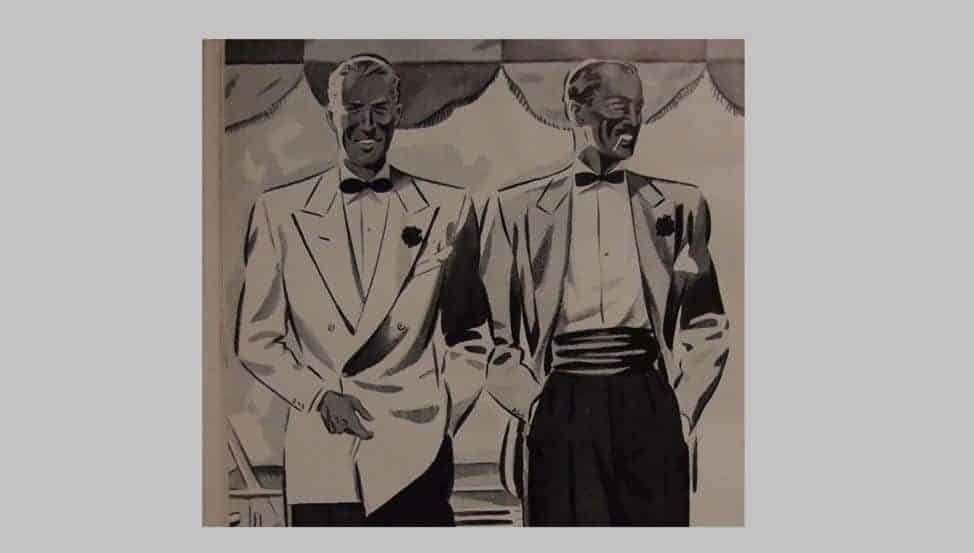
The History of the Cummerbund
Overall, it seems the accounts are a bit murky, but we’ve captured everything you need to know about it here.
The English word “cummerbund” originates from the Persian word “kamarband,” which means as much as “waist wrapping.” Yes, not a very original name, but you get it. The style originated probably from the Persians during the Mughal Empire, which ruled most of South Asia during the 16th century.
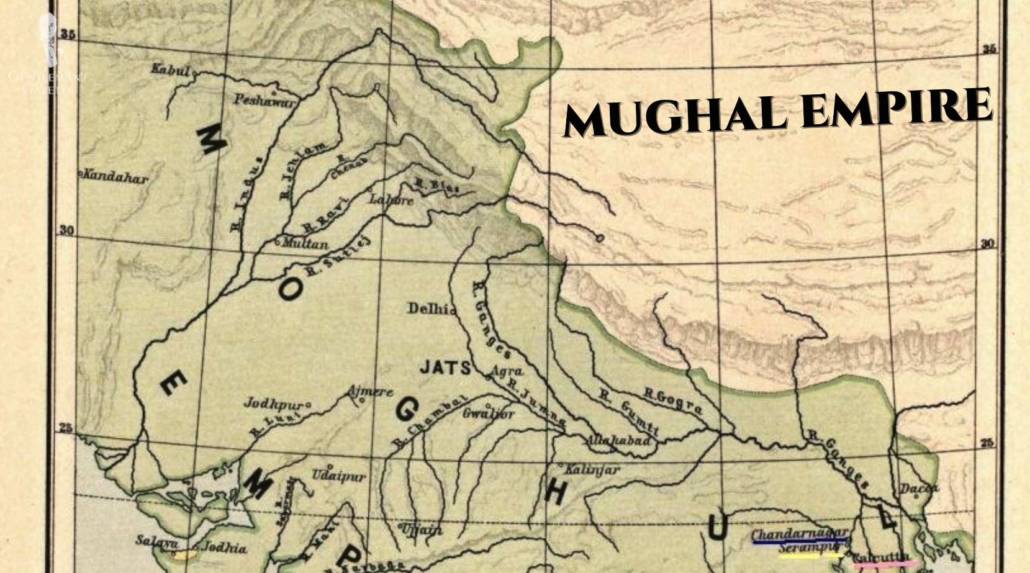
So, why did they wear it at all? First of all, it kept them warm. Second, it allowed them to carry things like tools or a sword. And, last but not least, it was meant to display wealth, especially if the cummerbund was made out of luxurious materials.
The fashion of wearing a cummerbund spread to many other countries including India, which is where the British first encountered it. British soldiers arrived in India in the early 17th Century and they just picked up the word and called it “cummerbund.” Of course, with a more English flair when it came to the spelling.
At first, it was used as a useful piece of military dress by the British but also other European countries. Around the same time, military sashes were really popular, especially in military settings. You can see that here in a painting that shows English and French soldiers.
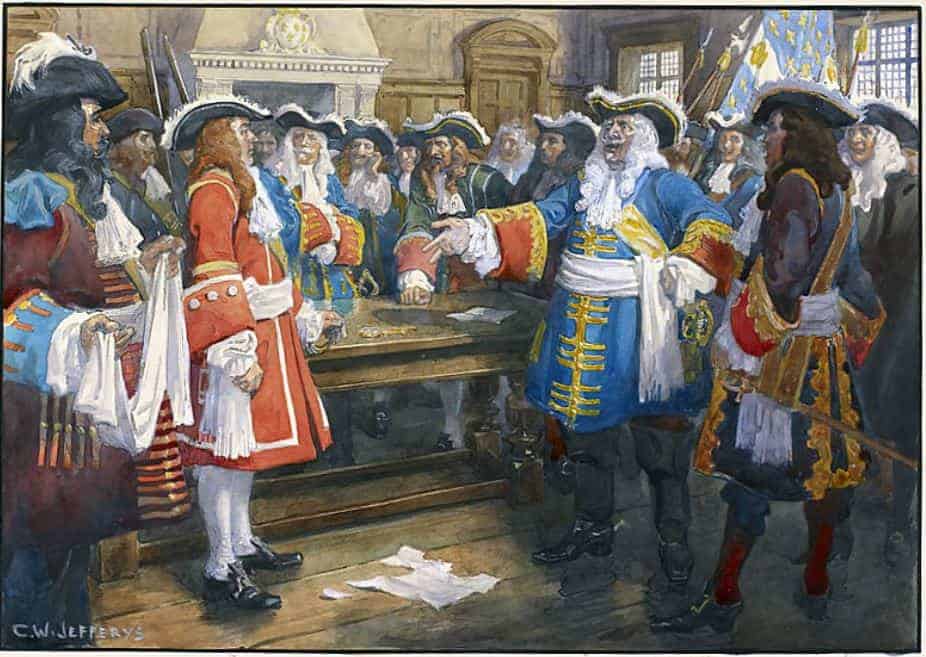
It’s very interesting to look at illustrations from 18th Century armies. If we look at the image of the Bengal Army from 1785 below, for example, we’ll see quite interesting waist coverings.
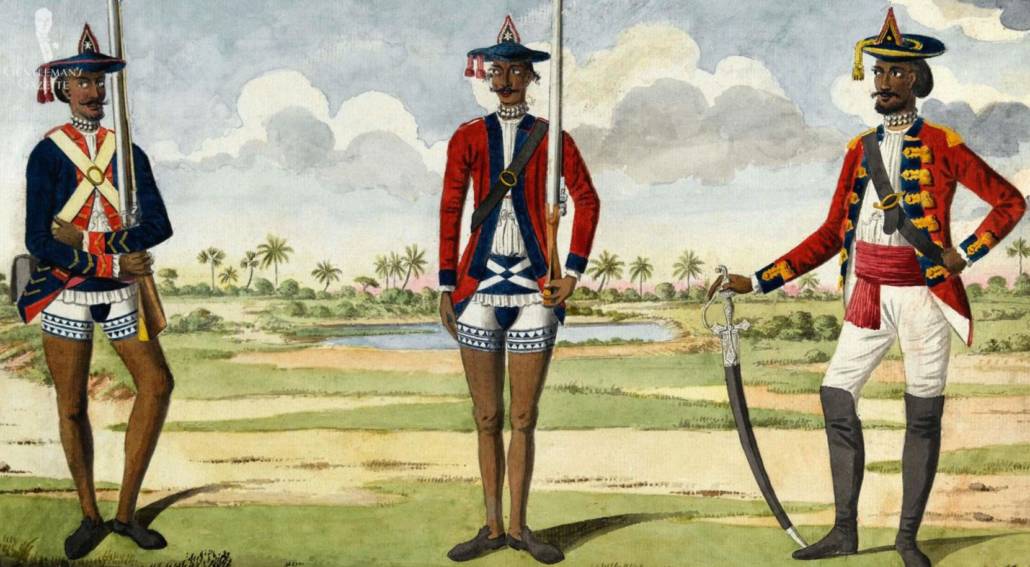
The word “sash” is still in use, mostly for shoulder and waist coverings, whereas cummerbund is specifically used for that piece of cloth that is wrapped around your shirt and waistline of your pants or trousers and connected in the back.
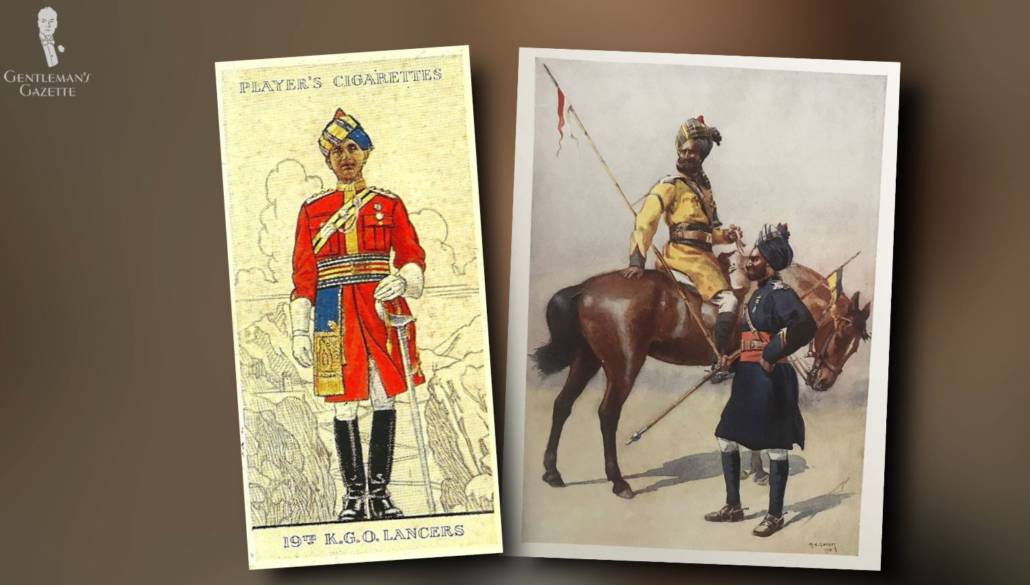
But, wait a second, how did this Mughal-fashion-turned-British-military piece of clothing become this staple in Black Tie evening wear? Well, India was a lot warmer than Britain and so, when the British observed that the Indian Sepoy troops wore those cummerbunds, they decided to also utilize them because, after all, it meant one less layer of fabric and, therefore, less sweating during the evening hours.
Looking at illustrations, it seems like the British first picked up the cummerbund as a part of their full dress suit around 1850. It really was either-or. You never wear a cummerbund and a waistcoat at the same time. Personally, I think every classic style enthusiast should have waistcoats and cummerbunds. It’s not an either-or proposition.
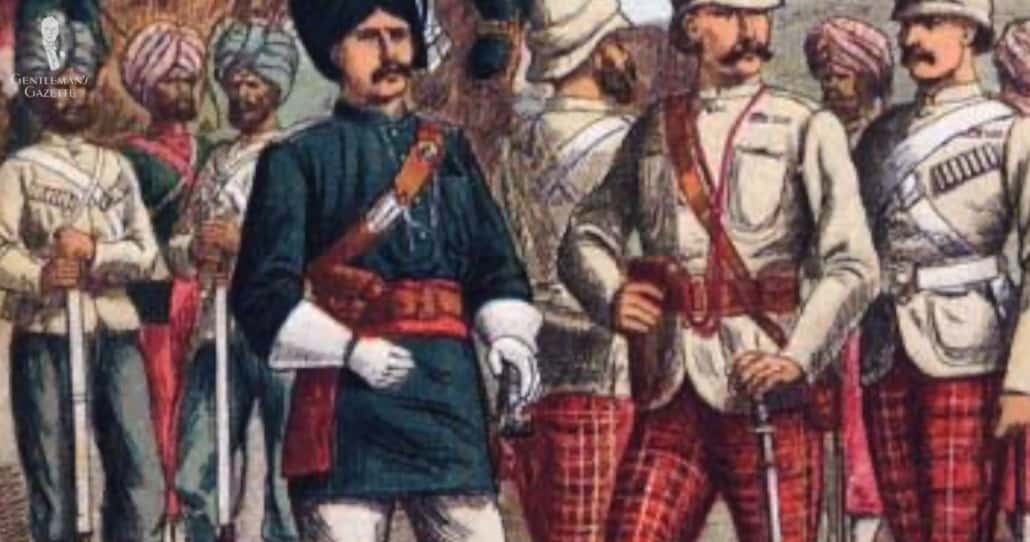
Just because the British soldiers wore stuff in India doesn’t explain how it got popular in England. In the 1870s, reportedly, the then Prince of Wales and, later, Edward VII returned from a tour of India to Britain. He decided to wear the cummerbund with somewhat more casual evening ensembles for smoking, yachting, or other more casual evening activities when White Tie wasn’t an option.
From there, it was picked up by nobility and the social elite and the cummerbund firmly established itself in the closet of many men.

It wasn’t just limited to evening wear anymore. For example, an illustration from 1890 shows someone casually sporting a cummerbund with daywear. Another illustration below from 1891 proves this point.
Sometimes, the cummerbund was even utilized for White Tie. Today, wearing a cummerbund with a White Tie ensemble would much rather be looked at as a faux pas rather than a fashion-forward statement. Nevertheless, some people still try it.
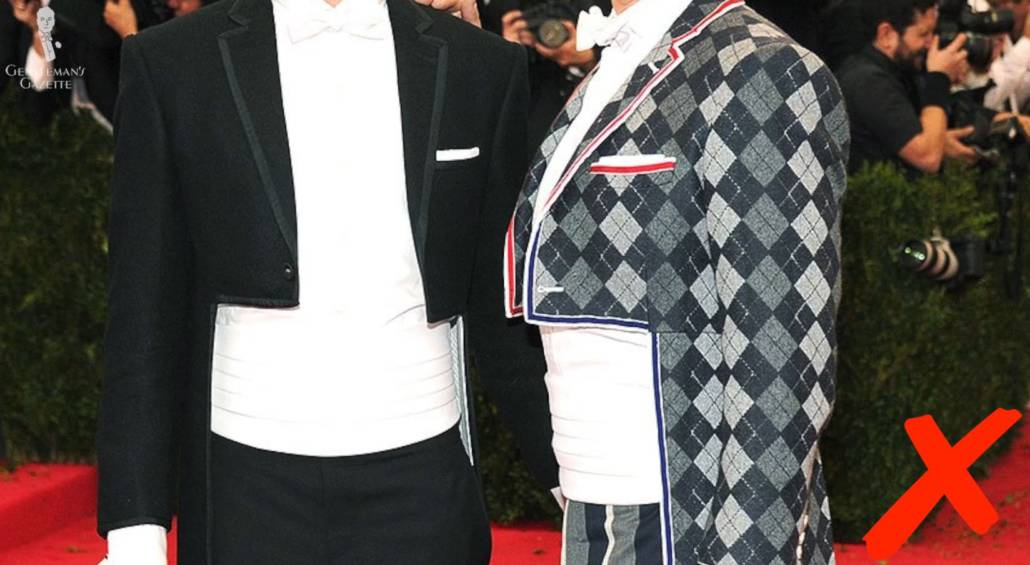
While evening cummerbund used to be black or dark, daywear varieties were often more colorful. Sometimes, they also had nice patterns. Some men even attached brooches and pins to it.
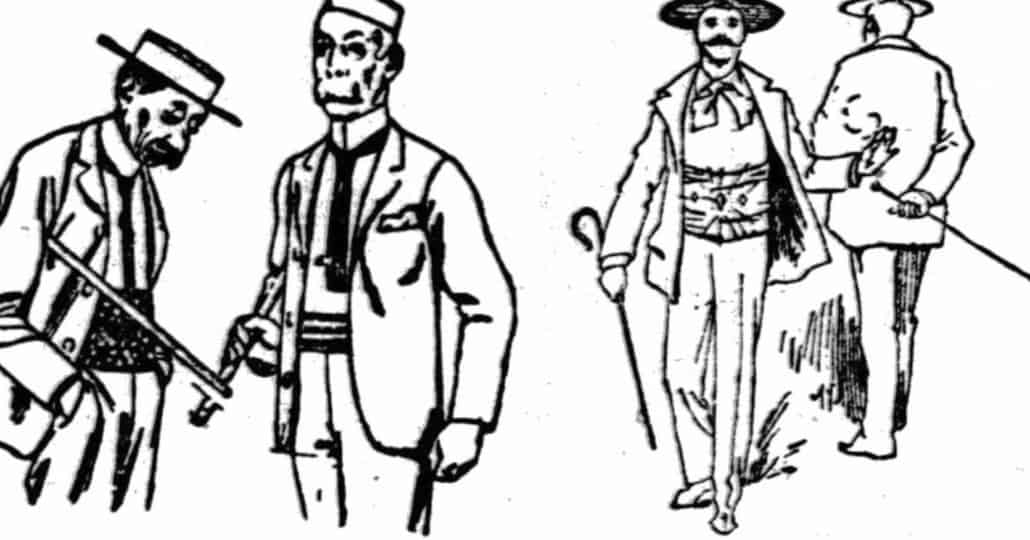
By 1895, the cummerbund had lost a bit in popularity. It basically disappeared from White Tie by 1895. There was also a new accessory called the “cummervest,” which was basically a cummerbund but it looked a bit like the bottom of a vest. And it meant to combine the best of both worlds. The cummervests never really became popular on a large scale, even though they flared up again in popularity in the 1950s and 60s.
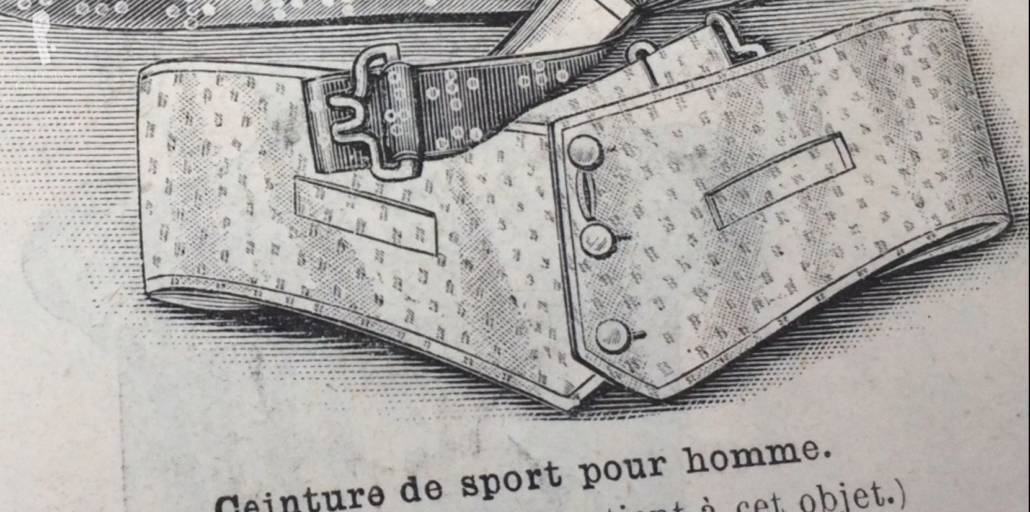
Heat and overheating and evening wear were always a matter of discussion. And so, in the 20s and 30s, the backless waistcoat was developed specifically for evening wear so you could dance and you wouldn’t have that extra layer of fabric that just made you sweat. Nevertheless, some people still prefer cummerbunds. And so, they stuck around.
During World War II and rationing, the waistcoat used up a lot more fabric than a cummerbund. So, it became more popular again to have your cummerbund. During the 50s, as part of the continental look, as I said, cummervests made a brief comeback, but cummerbunds were still around, often in flashy patterns and loud colors.
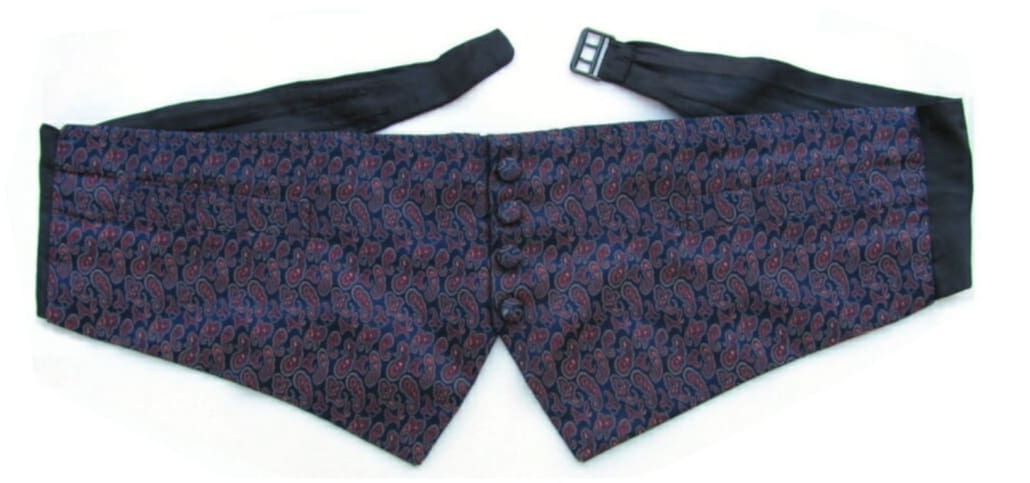
When ruffles on shirts became more popular again in the 1960s, 1970s, the waistcoat fell out of favor again and you had more cummerbunds. Also, you now sometimes saw a matching set of the bow tie and the cummerbund being made of the same material and, often, it wasn’t black but, maybe, light blue. I, for one, am really grateful that ruffles have disappeared from men’s evening shirts.
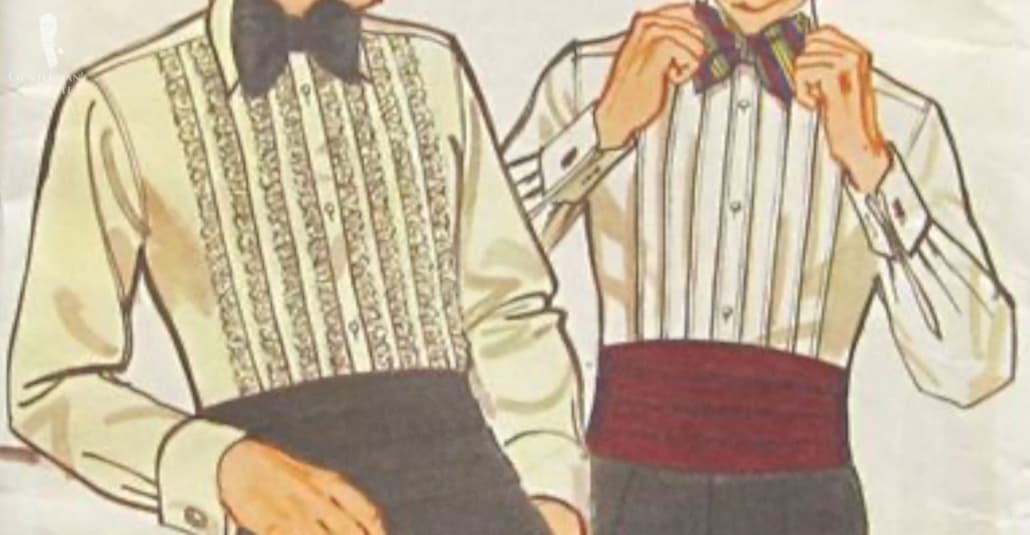
Should You Wear A Cummerbund Today?
Basically, you have two options. Either you wear a cummerbund, or you wear a waistcoat. It is not acceptable to wear nothing, except if you’re wearing a double-breasted jacket.
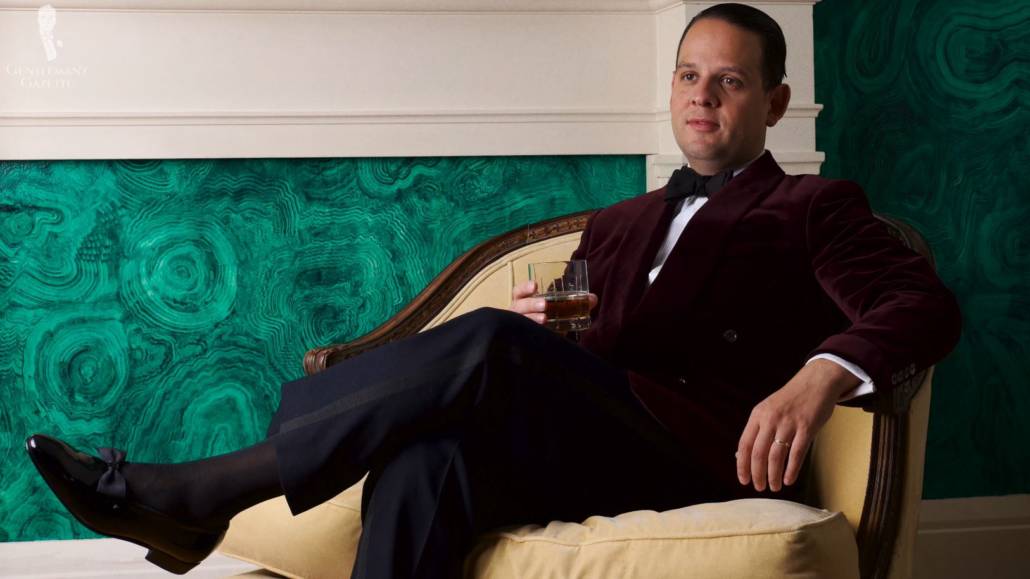
When looking at red carpet affairs, sometimes I see men wearing a single-breasted tuxedo without a cummerbund and it just looks unfinished because the waistband is exposed and, typically, the evening dress shirts that men wear at the bottom are not properly finished and maybe you can see plastic buttons, not a decorative studs and it just looks very incomplete.
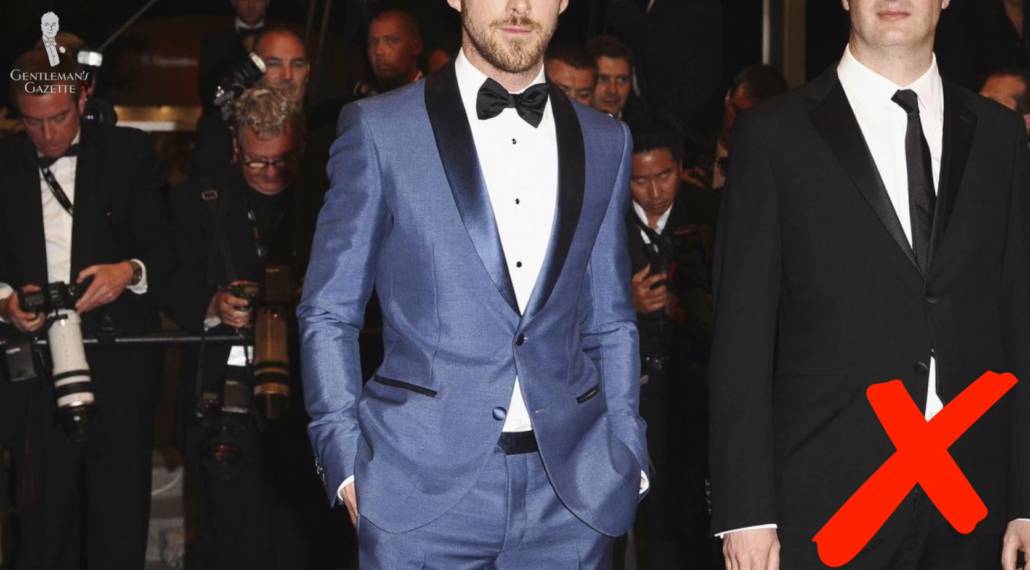
If you take a closer look at the shape of a cummerbund, it is not a straight piece of fabric, but it is elongated and round, almost oval. Aesthetically, it creates a very pleasing line when worn on your waist because it makes you look slimmer, not bigger.
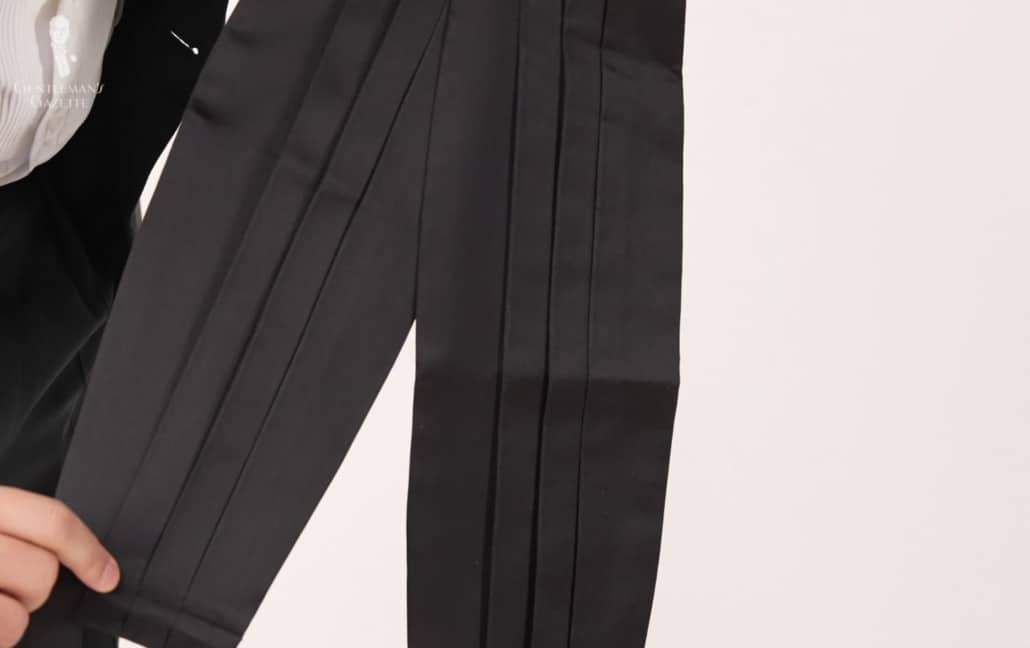
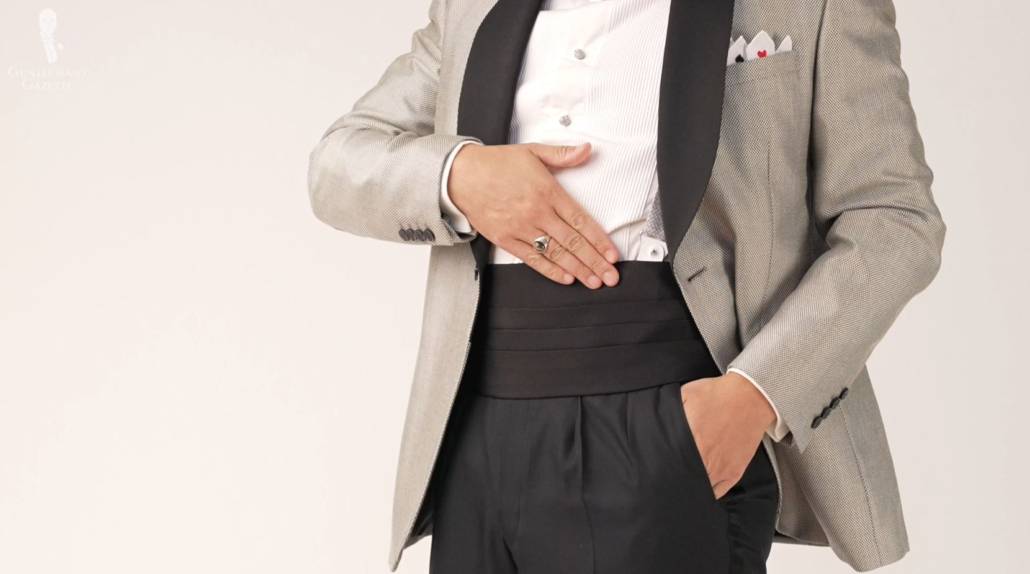
In my mind, this line provides a certain element of visual interest and creates a nice proportion between your legs, your jacket, and your torso. Visually, it makes your torso look a bit shorter and your legs longer. Because of that, most men will look a bit slimmer when they wear a cummerbund and who doesn’t want that?
If you want the most classic and formal look with the tuxedo, I suggest you go with an evening waistcoat, either a Black Tie one or maybe even a White Tie model. That, however, is the subject of another guide.
If you’re a taller gentleman or maybe if you have long legs and a short torso, you may wonder, “Will the cummerbund make my torso look even shorter and my legs even longer?” Well, there are different ways to wear it. But, when worn properly and I’ll show you how, it should always flatter you no matter what height.
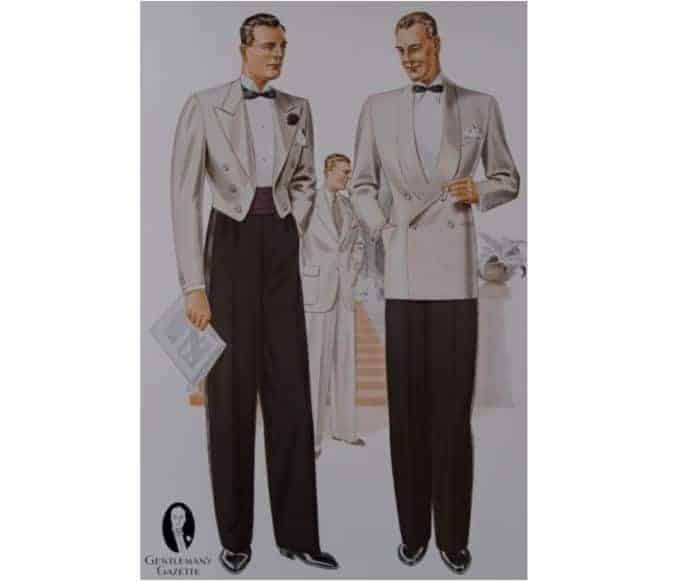
As mentioned earlier, cummerbunds are fantastic for warmer climates wherever they may be and, as a gentleman interested in classic style, you’re well-served having waistcoats and cummerbund.
Having different options also makes your ensembles look different. So, if you’re going on a trip and you just have one tuxedo, having a few different cummerbund and waistcoats make it not look too boring and dull or the same night in and night out.
What Should You Look for in a Cummerbund?
First of all, the modern cummerbund is fairly standardized. Typically, it has three or four pleats and it is made out of silk or silk-like material. In the back, you’ll find some type of closure. Some have a Velcro system, others allow you to tie it together, or there are sometimes clasps and there are even size adjusters, either with buttons or with elastic straps or both.
So, why are there pleats? Well, think back to history. It used to be a sash that was just wrapped around and, of course, if you wrap multiple layers on top of each other, you naturally get those pleat-looking things and that’s what the cummerbund today is supposed to emulate.
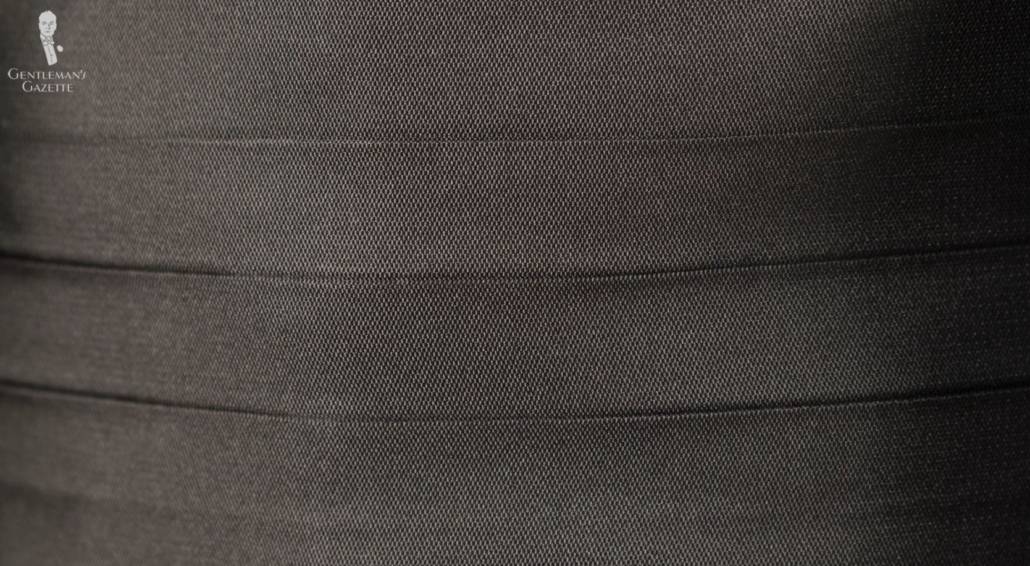
Back in the day, some gentlemen would even put their concert or opera tickets into their cummerbund pleats. Today, with the rise of the smartphone, that’s probably not a big thing anymore.
Construction
Most men today wear a cummerbund only on rare occasions when they wear Black Tie, not for day wear. And so, most cummerbunds are designed for one or two-time use out of cheap materials, and it’s kind of a throwaway item. If you’re a musician or a clothes enthusiast, you want a cummerbund that lasts a lot longer.
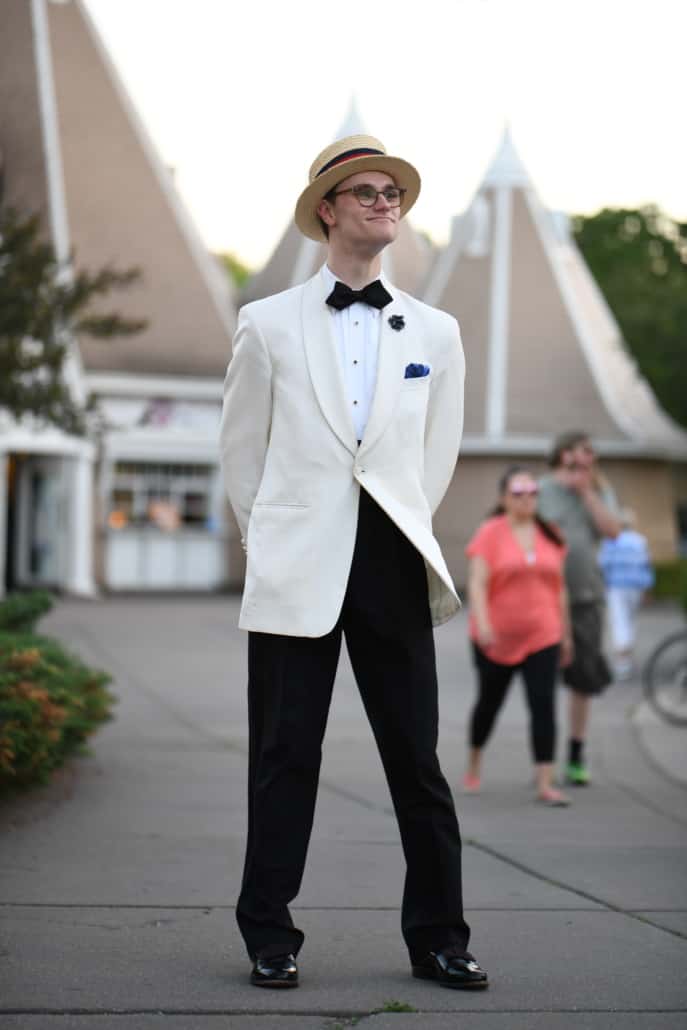
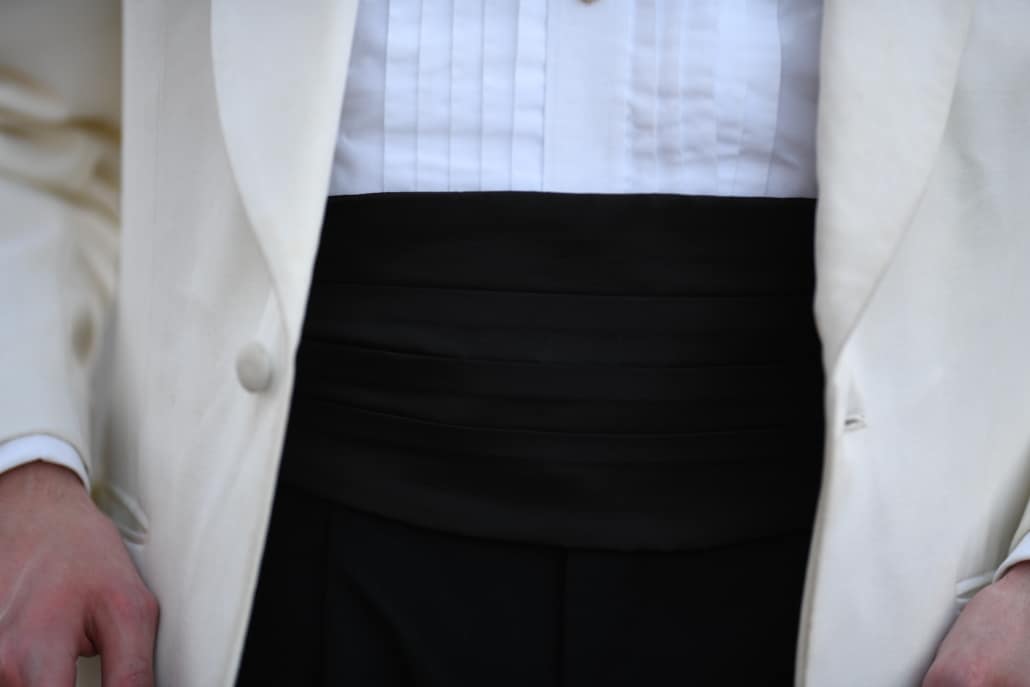
First of all, you have to decide “do I want the back of the cummerbund to be made out of silk as well?” Silk is a material that doesn’t hold the color when it gets really hot and wet. So, if you’re dancing a lot, if you’re in a really hot environment, make sure that the back of your cummerbund is not made out of 100% silk because it may color off, especially on your white shirt. Basically, any other lining that doesn’t discolor and come off will do because you won’t see it from the front.
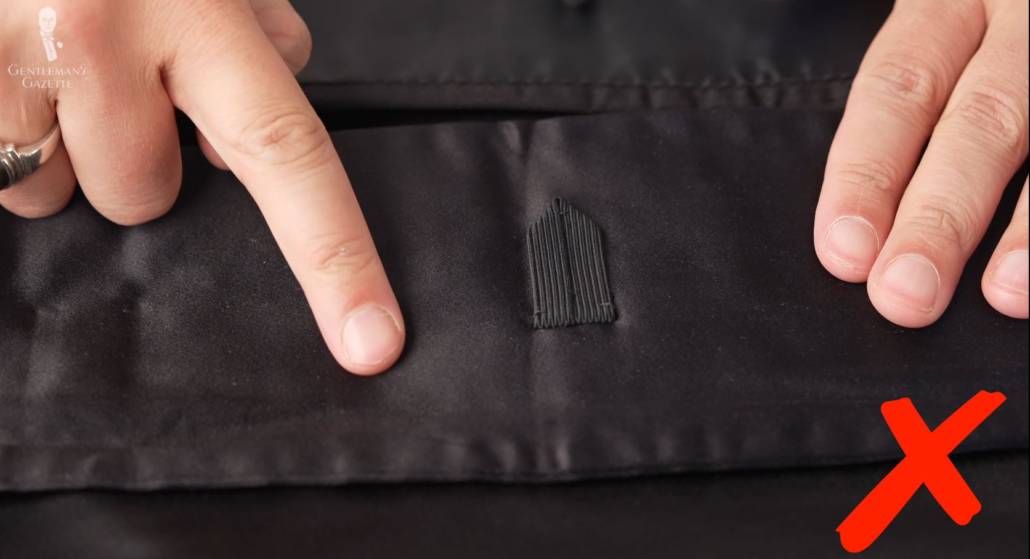
Second, you want a little loop that is straight in the middle of the cummerbund so you can button that in to the front of your trousers, therefore ensuring that the cummerbund always stays in the right position, covering the top part of your evening shirt as well as the waistband of your trousers, pants, or slacks.
The other thing you want to pay attention to is sizing. Most garments come in one size. But, most people don’t. That’s when size adjusters come in.
For example, at Fort Belvedere, we have elastic straps on the side and we had additional options with buttons to adjust the length of the cummerbund so it fits you properly. We realized that some men are so slim that even that is too big. So, we created a cummerbund in a different size that was smaller and specifically meant for men who have a very slim waist such as Preston for example.
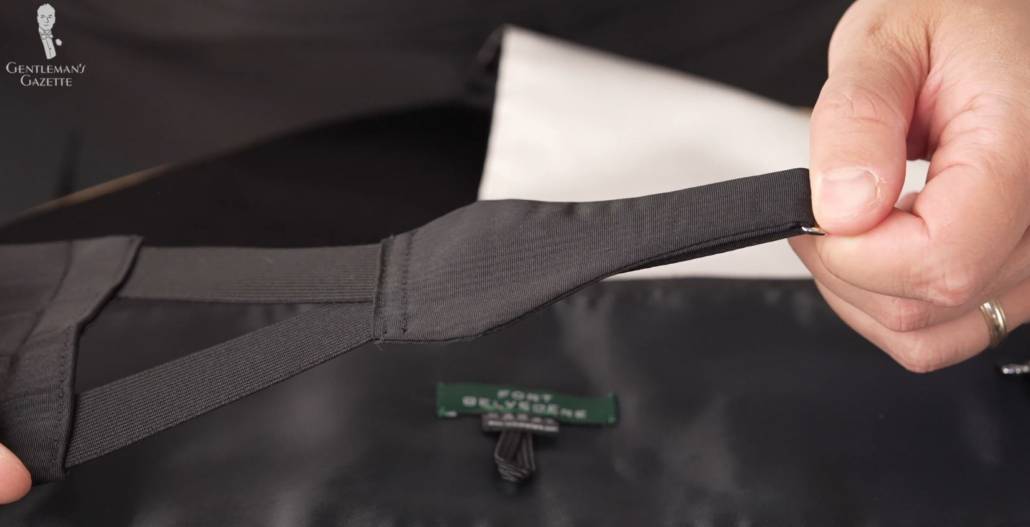
The other thing to pay attention to is the closure buckle. Ideally, it’s not huge but rather small because, when you sit, you don’t want to feel the metal pushing into your back. Sometimes, you can also find cummerbunds that you can tie by hand. But that leaves a big knot and I find them to be a bit uncomfortable to actually wear and sit with.
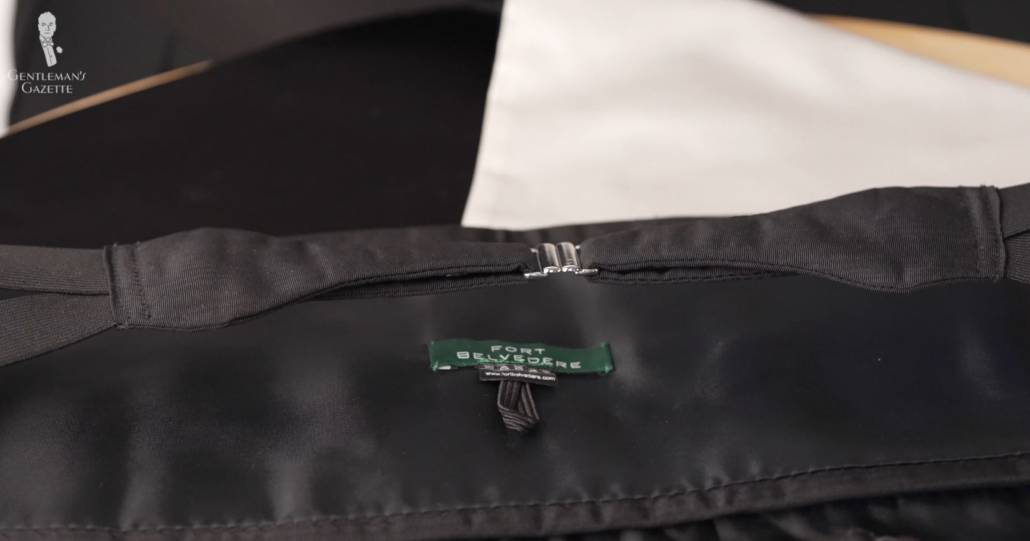
Materials
Because the cummerbund is such a decorative piece, it’s important that you have the right material and that is silk. Why? Well, silk has natural luster, which lends itself to evening ensembles. Most quality cummerbunds are made of silk satin today, which is a weave that is rather shiny.
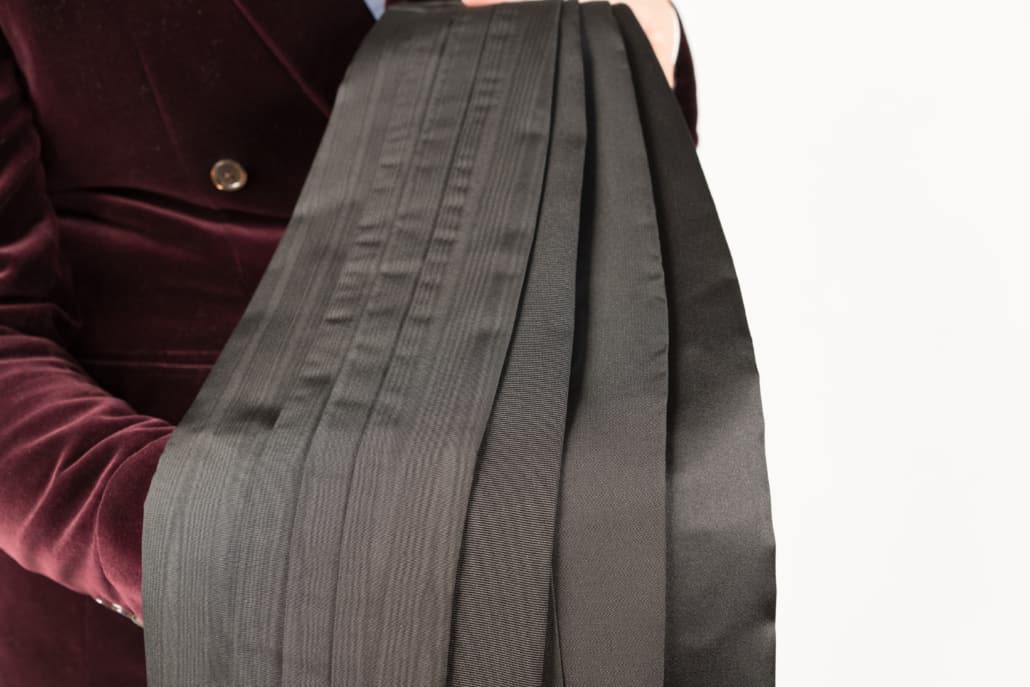
There is a warp satin and a weft satin, and the weft satin is easier to produce and is what you will find in most cummerbunds. The warp satin is more expensive to produce but has a superior luster.
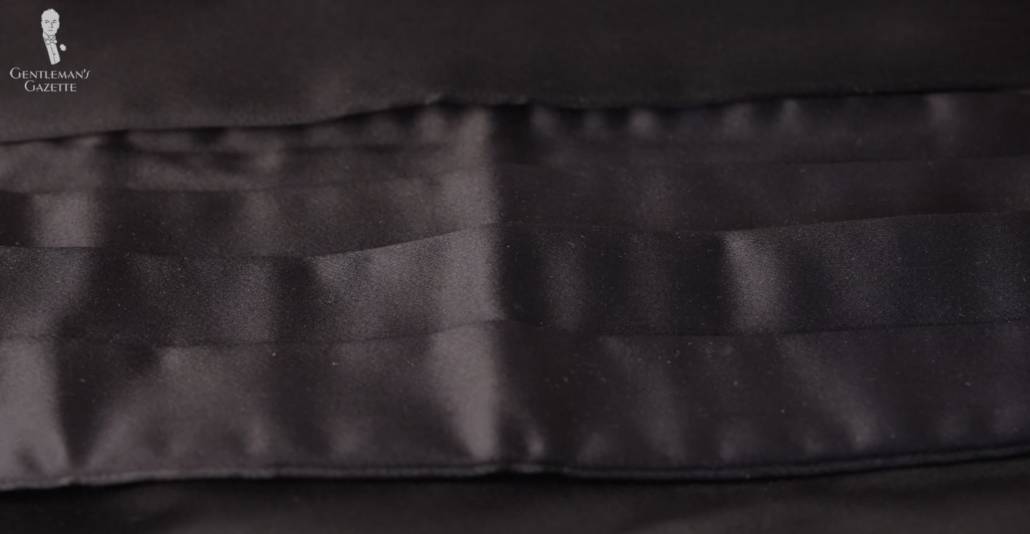
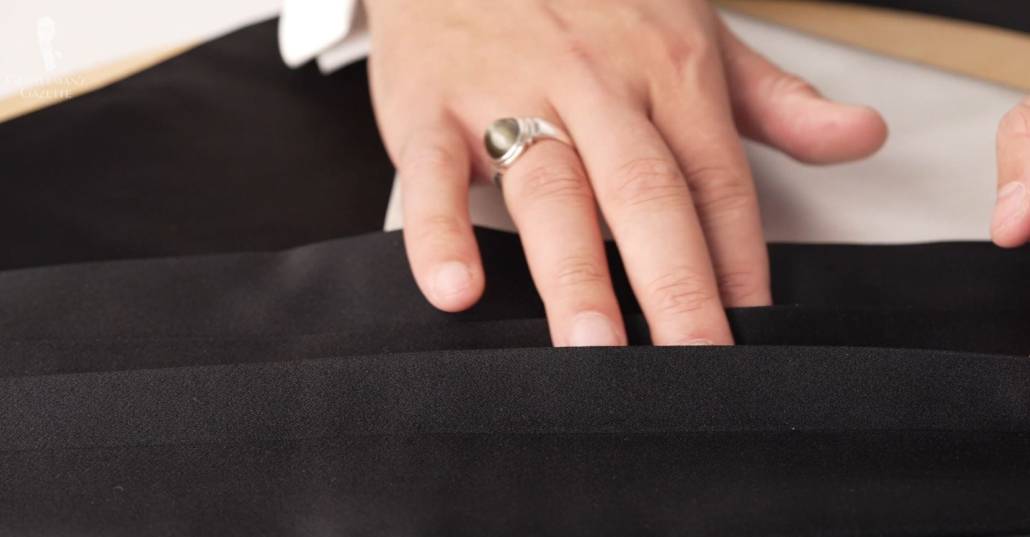
So, at Fort Belvedere, of course, we use warp satin, which is made for us specifically at a small mill in Italy that’s specialized in evening silks. It’s more expensive, but it’s heavier and has a nicer luster and it shows. I can tell immediately if you’re a polyester or nylon satin or maybe a rayon blend or whatever it is. It just doesn’t have the same look and also not the feel.
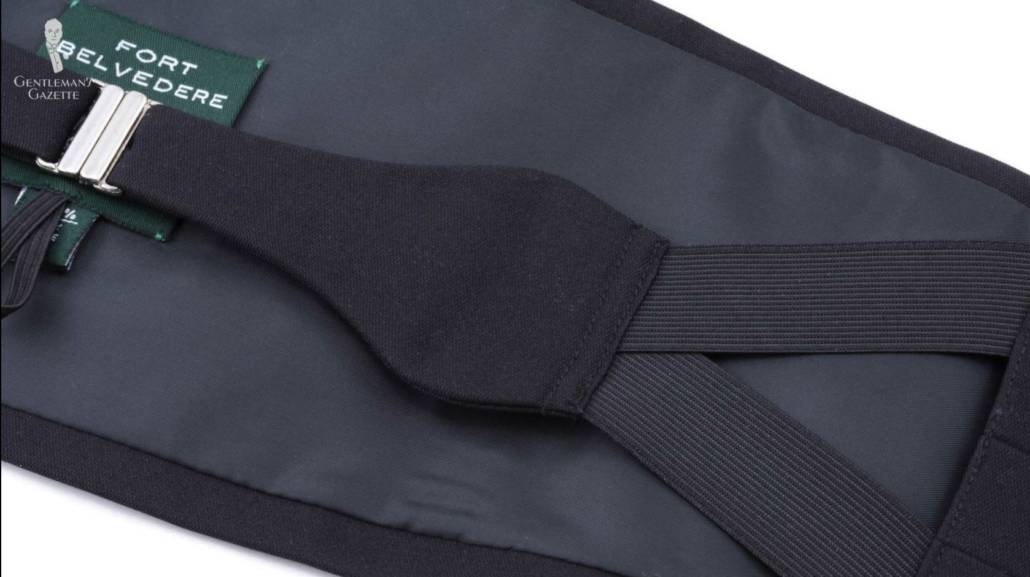
Ideally, the material of your cummerbund matches the facings of your lapel or your shawl collar as well as your bow tie so you create a harmonious look. At Fort Belvedere, we have a large selection of bow tie materials. We have different kinds of grosgrain, we have moire, we have satin, we have barathea, we have faille, and, in line with that, we offer you cummerbunds in the same materials so you can create that same look.
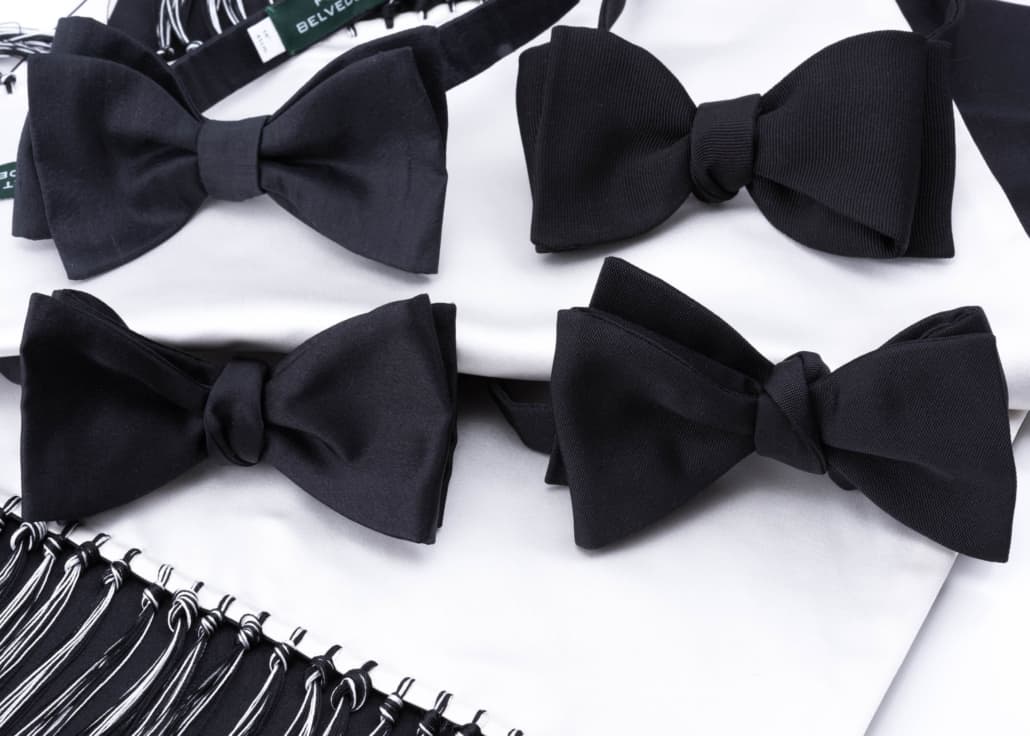
For example, in this outfit, my lapel, my shawl collar has this kind of fine grosgrain silk and so, I’m wearing a grosgrain bow tie with a grosgrain cummerbund. If you’re not sure what the lapel facing is on your jacket, take a closer look and compare it to the bow ties and the cummerbund we offer in our shop. They’re very close-up shots. You can exactly see what a texture is like.
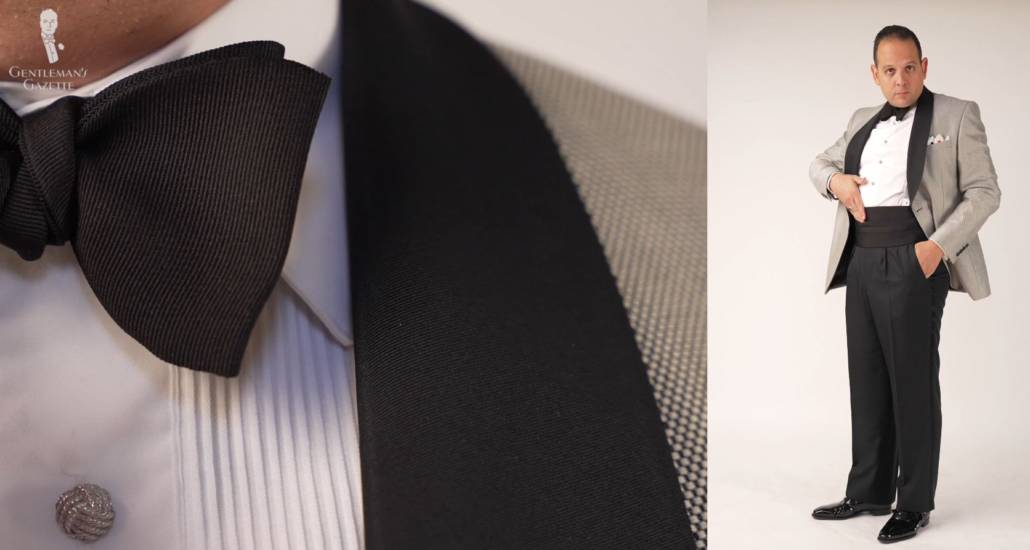
1. Grosgrain
Faille or grosgrain has these ribs. It’s typically the second pattern a clothes enthusiast buys after they’ve already purchased the satin.
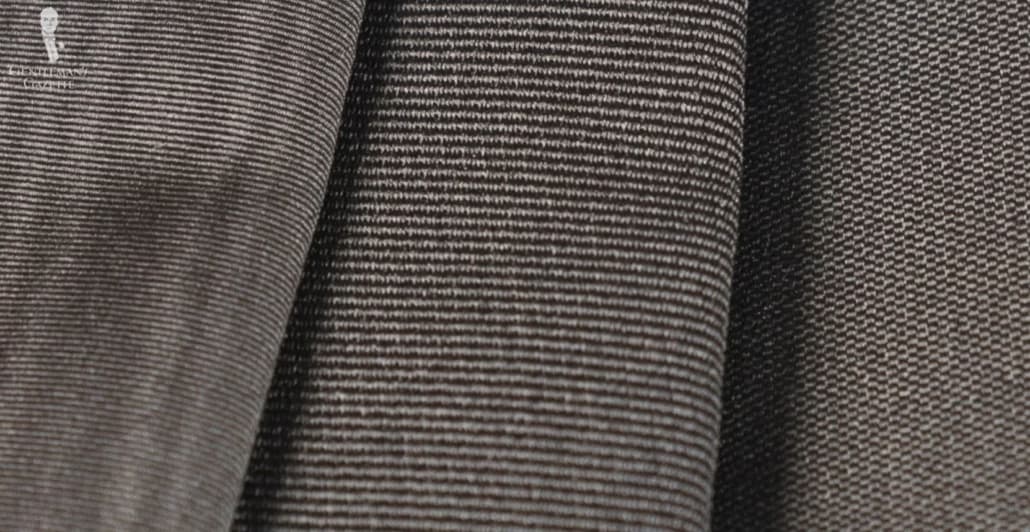
2. Barathea
If you want something that’s duller, I suggest you go with a barathea weave, a fabric because it doesn’t have that luster, but it has a nice, interesting texture and it is a popular Black Tie fabric, especially in Great Britain. Originally, it was a trade name. If you’re more into fabrics, you also know it as an “amure fabric.” It was really popular in the 30s and 40s when there was a variety in evening wear fabrics. Today, most men just ever get the satin because it’s the first and only thing they buy.
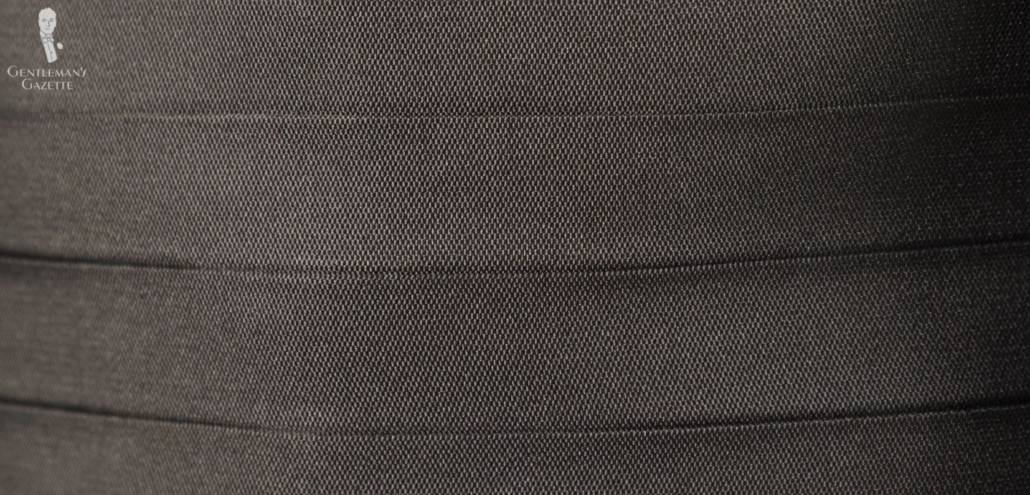
3. Silk Moire
On the flip side, if you want to be special and a little more lustrous but you don’t want to go with the satin, the silk moire may be for you. It has the effect of a water silk, but is actually achieved by pressing two layers of fabric through a roll. And it’s typically made on a fine grosgrain fabric to get that really cool look.
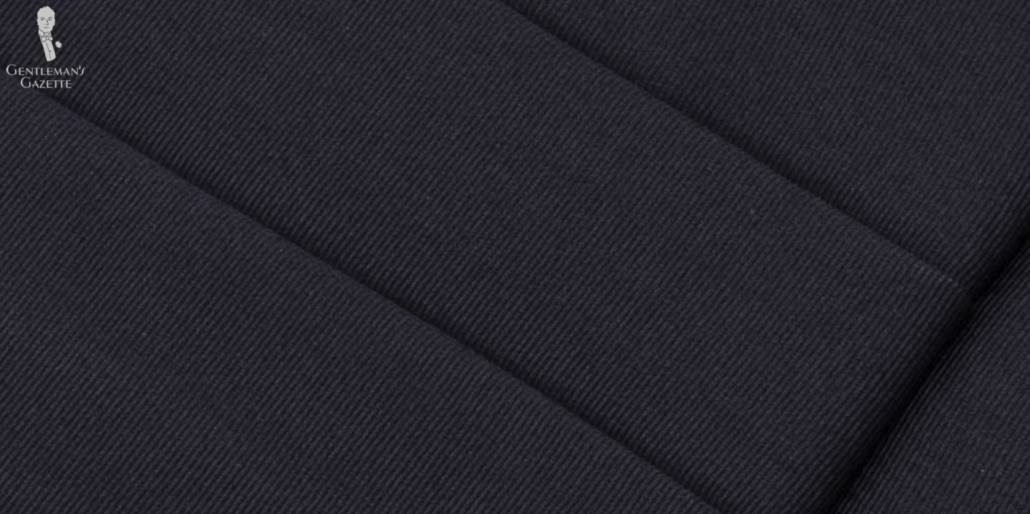
Nowadays, most moire looks are just achieved by weaving it in a certain way, not in the original traditional way where you put two fabrics through a roll. I found a small Italian mill that still really understands how to do that. So, the silk moire that we use at Fort Belvedere is the real deal and not an inexpensive substitute.
So, for the genuine Black Tie connoisseurs, a true silk moire cummerbund and bow tie are definitely of interest.
4. Wide-Ribbed Grosgrain
If you’re interested in a bolder cummerbund, I suggest a wide-ribbed grosgrain because, unlike the regular grosgrain, you can really see the ribs, and it looks really cool with the same bow tie. You can even wear it if you have a satin lapel or shawl collar because it’s so different that it’s obviously a different look, and no one thinks, “Oh, you just tried to match it, and it just barely didn’t work.”
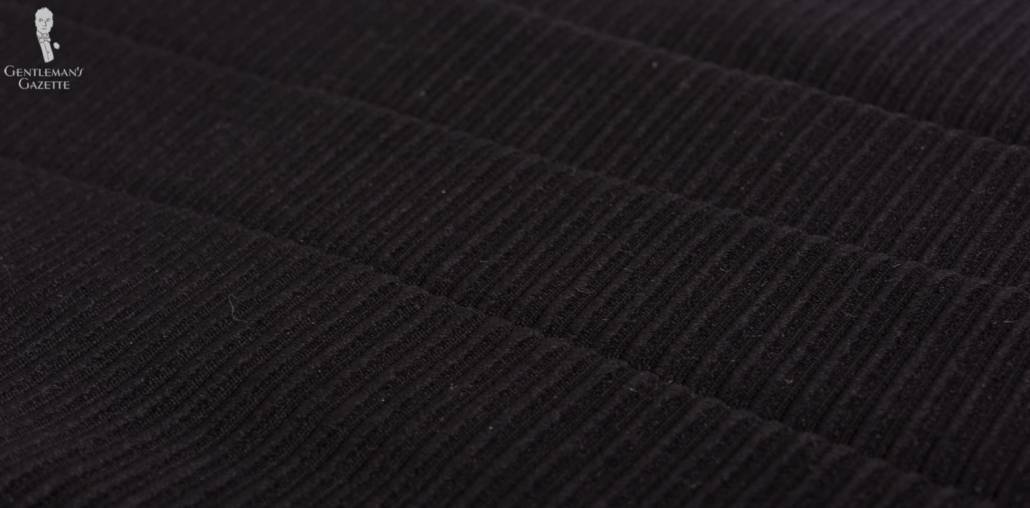
Colors
Typically, cummerbunds are part of sets with a matching pre-tied bow tie, and we’ll always advise staying clear of that because it looks like a small boy who goes to prom, not a well-dressed gentleman.
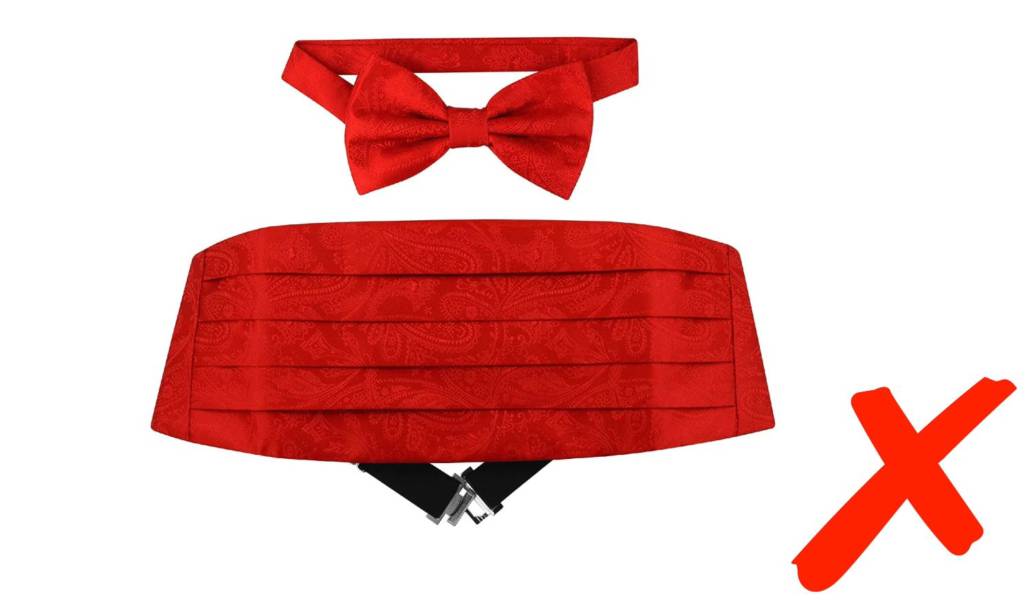
That being said, reputable brands offer cummerbunds and sometimes bow ties in different colors. I think, for a Christmas or holiday party, having a tartan or check cummerbund can actually look quite nice. It adds a dash of color. It’s different. But, if you do that, I suggest you keep the bow tie black and maybe the pocket square white and have that single piece be your accent piece in the sea of black and white. They’re really more of a special item for the men who already have all the black ones and the different materials and weaves. I have a few of them as well. But, frankly, I hardly ever wear them.
Closures
When it comes to closures, there are many different options and buckles. Personally, I don’t like the feel of Velcro because I feel a Black Tie outfit is something elegant that is high-quality, and Velcro is something that, maybe, my 95-year-old grandpa or my 4-year-old daughter wears for functional reasons, not something I want in a nice evening outfit.
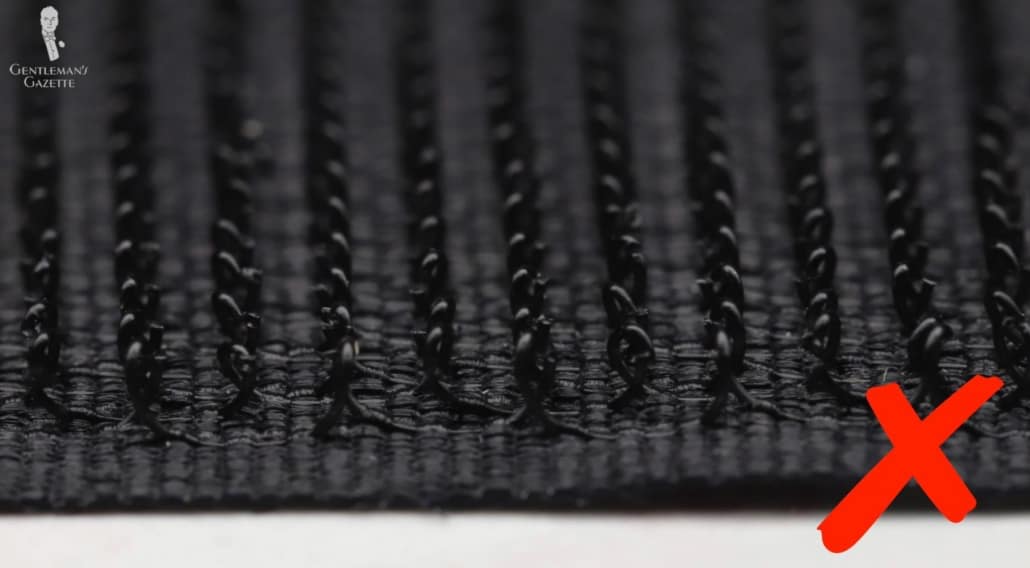
Otherwise, in our mind, the exact type of closure doesn’t matter as long as it closes and it’s comfortable to sit on. Most companies don’t even think about that. At Fort Belvedere, we wear all that stuff and we want you to have a wonderful evening. Therefore, we choose stuff that doesn’t hurt or is uncomfortable.
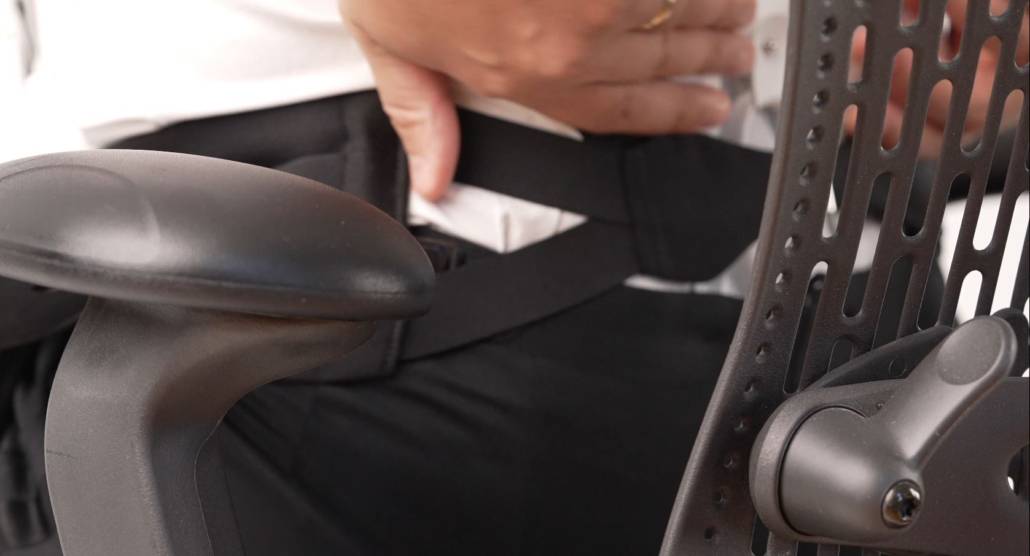
Also, we really wanted the elastic part because, when you sit and when you stand, your waist circumference can change. But, if your cummerbund doesn’t change, either something pops, or it’s just uncomfortable for you. Just think about having a large meal, and you want your cummerbund to fit well and be comfortable before and after you eat.
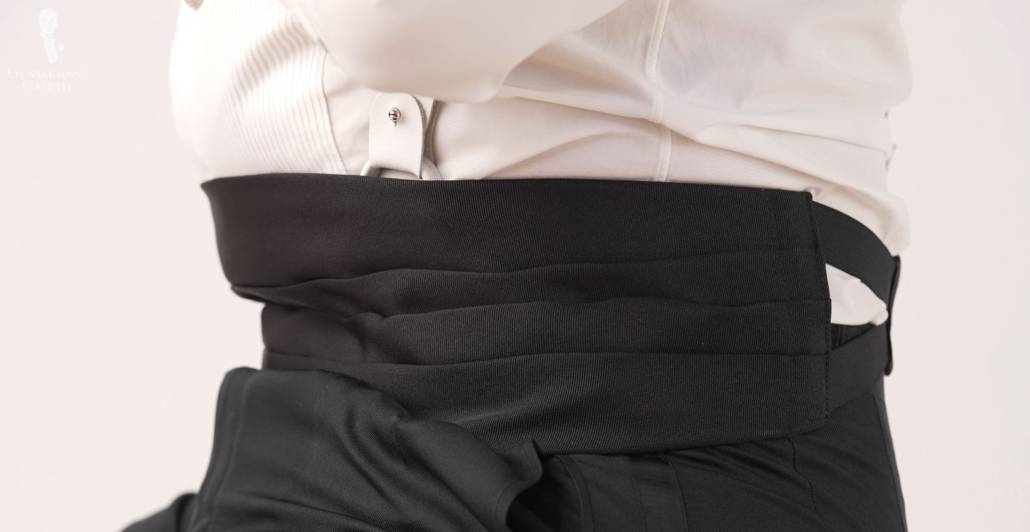
Fit
So, how should a cummerbund fit? Basically, it should fit snugly but not too tight. You want it to cover the waistband of your pants and the bottom part of your evening shirt, so everything looks neat and, maybe, you know, the bib or the end of it is standing out, or you see a plastic button instead of a stud. All that is supposed to be covered up by the cummerbund. Therefore, you want that loop, so it holds it properly in place. Otherwise, over the course of the evening, the cummerbund may slide up or down, depending on your physique.
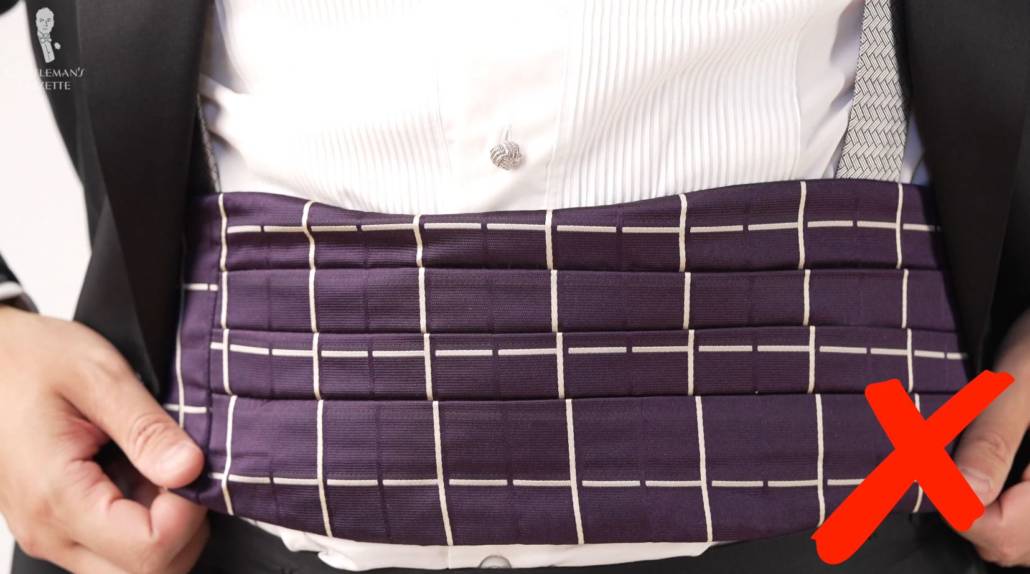
Generally, the pleats in a cummerbund should historically always face up. That being said, in some military regiments, it is specifically advised to wear the cummerband with pleats facing down. For example, the US Army guide, on page 138, specifically mentions wearing the pleats down.
Because the garment is ideally buttoned onto your trousers, your pants, the rise of the pant is important. Most modern pants have a very short rise, meaning the cummerbund would also sit very low on your person, whereas traditional classic pants are cut a little higher in the rise. This means they sit more on your natural waist, which is, ideally, also where you want your cummerbund to sit.
Keep in mind, though, the most important thing is that you cover that gap between the shirt and the waistband. If you wear your cummerbund too low at like belt height, it may look like you have very short legs, and it’s just odd.
And while I mention it, if you have a cummerbund, never wear it with a belt, it would be: (a) somewhat redundant, and (b) the belt would kind of bulge up underneath the cover bun, and it would look ugly.
If you’re wearing pants that are super wide and you don’t have a chance to go to a tailor, most proper evening shirts have a little tab at the front that allows you to connect the shirt with your trousers and then the cummerbund with the trousers as well. That way, it’s all one unit, and no matter how you move or how elaborately you dance, it all stays properly in shape.
Styling Dos and Don’ts
Unless you’re into costume history or you just like the look of it really very much, I suggest you wear the cummerbund with evening outfits only. And if you do so, wear it with a bow tie. Not with a necktie or an ascot or anything else.
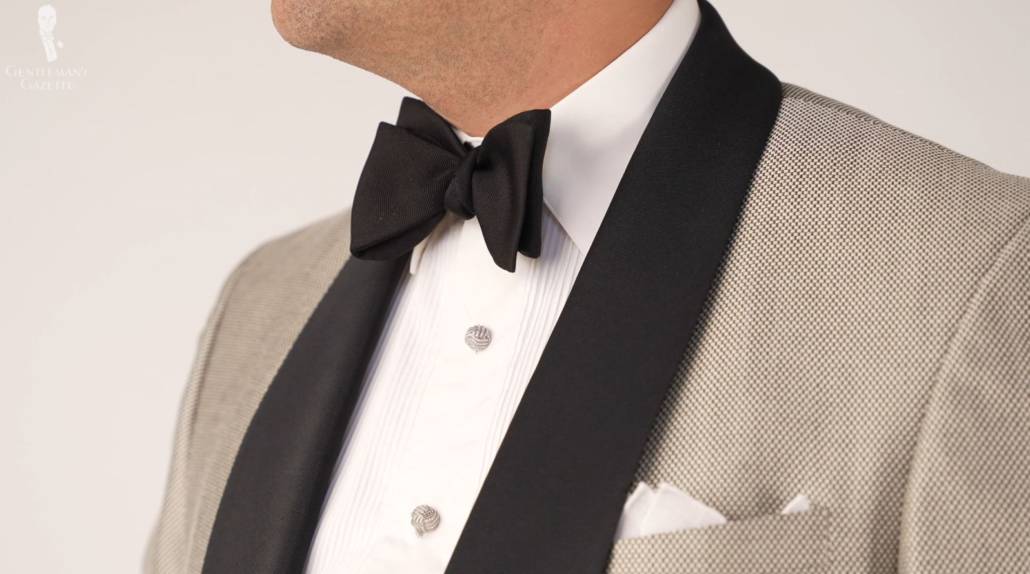
If your cummerbund is black, you also want a black bow tie. If your cummerbund is in a different color, I still suggest you go with a black bow tie. Try to avoid the matching colors because it looks like it came from a cheap set at the rental place down the road. Maybe a very dark maroon in the same color bowtie and cummerbund may work. But, if you’re at that level where you think about that, you can probably pull it off. If you want to set an accent with your cummerbund, it’s okay to do so.
Maybe choose the same color as the boutonniere. But, otherwise, keep to one color that is not black or white. Otherwise, there’s too much going on, and it destroys that somberness of a Black Tie ensemble.
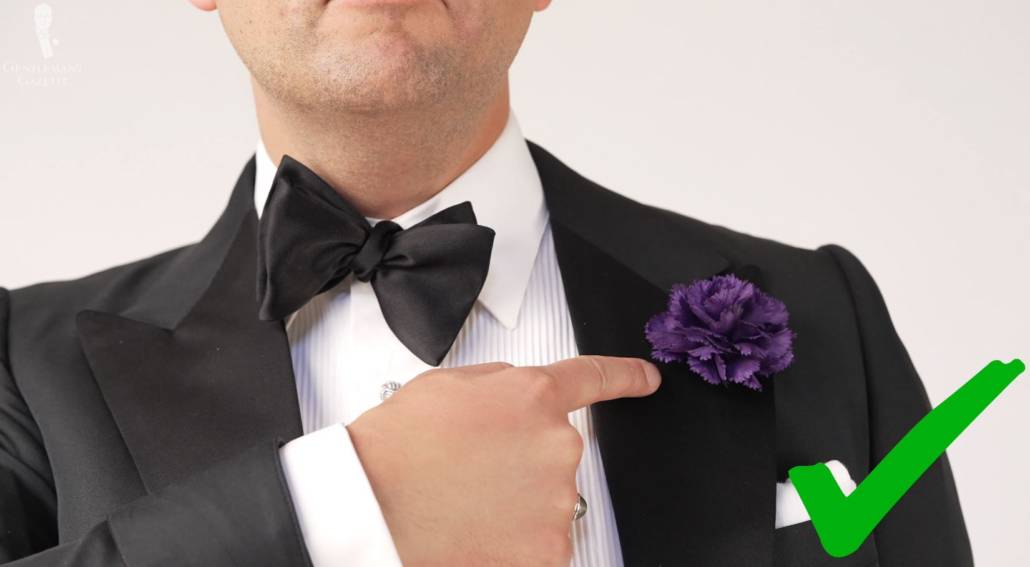
That being said, maybe if you have a purple and white cummerbund and then a purple and white pair of socks and it works together, maybe you can pull it off because the socks aren’t visible at all times. But, that is definitely more advanced.
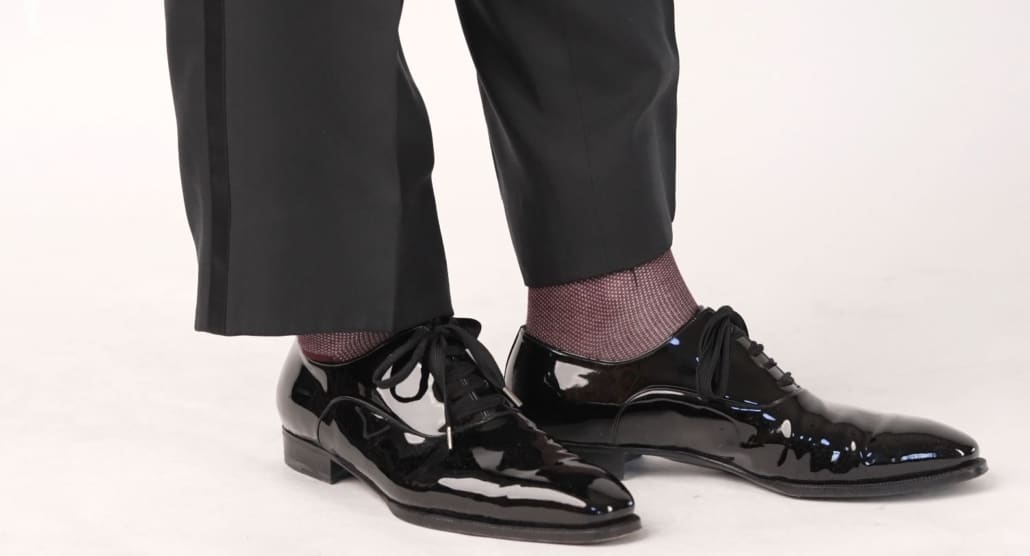
Otherwise, if you want something colorful, I suggest sticking with classic patterns such as tartans, maybe a black Blanche tartan or a red and green tartan for Christmas, or maybe a dark burgundy because that’s just not super flashy.
Cost
It’s more than 10 bucks. Just the fabric alone we use for our high-quality Fort Belvedere cummerbunds cost a lot more than that. In my mind, between the $200 and $250 price points, you get really good ones. And if that’s too much for you, maybe you can find a high-quality one on places like eBay or the vintage store.
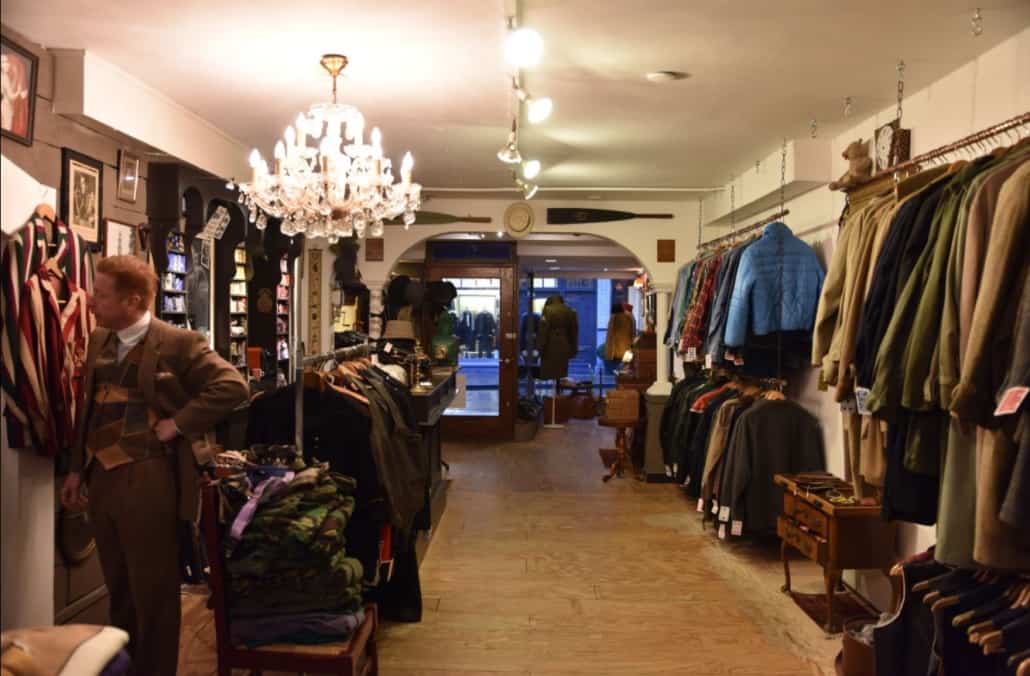
But then, of course, you have to find exactly the right size, and it may be hard to find, especially when you need it the most. Also, if you buy a black cummerbund, I suggest you buy it from the same source where you can find a matching bow tie for your cummerbund.
Why? Because even though you may buy a silk satin cummerbund from one brand and a silk set and bow tie from another. Maybe the one is weft satin, and the other one is warp satin, and they won’t work together. They will likely look different in terms of luster. So, you want that unique uniform look where the bow tie and the cummerbund are made of the same material.
Conclusion
In conclusion, then, we hope that defining and examining the cummerbund today underlined its importance in a classic Black Tie ensemble, and help you consider wearing them to improve your stature and look your best.
Do you own a cummerbund? If not, would you invest in this underrated, elegant piece? Let’s talk in the comments section!
Outfit Rundown
So, in today’s video, I’m wearing an evening waistcoat–just kidding! It consists of an unusual dinner jacket in silver and black from Gagliardi. It has a shawl collar that has a grosgrain silk on it and so, I chose a grosgrain bow tie from Fort Belvedere with a matching grosgrain cummerbund, pleats facing upwards. The dinner jacket even has an interesting lighting. Didn’t expect that, huh?
My evening shirt is pleated from Brooks Brothers. I’m wearing it with silver shirt studs that match my cufflinks. It’s a monkey fist knot and it’s a matching set. For my pocket square, I wanted to do something different than the plain white pocket square, so I chose this one here with the different card suits which were hand embroidered onto fine linen. My black trousers are part of a different set of tuxedo and have a very light weight, it’s very comfortable to wear and it has a full lining. They have a satin strip down on the side which identifies it as an evening trouser, and it’s custom-made.
The pants are held in place by a pair of suspenders, it’s a Fort Belvedere prototype in a black and silver silk pattern that picks up the color of the jacket. My feet are wearing a pair of black, capless, patent leather oxfords with evening shoelaces. I could have put in some grosgrain laces but I was too lazy and just left in my barathea ones. They have silver tips which works with my silver jewelry including my ring which is a hawk’s eye. My socks pick up the pattern of the jacket, they’re the two-tone solids from Fort Belvedere in gray and white. They’re not silk but they’re Tactel, which is much more durable than silk especially when you wear it on your feet, but it has that nice luster and you can clearly see it’s perfect for evening wear.
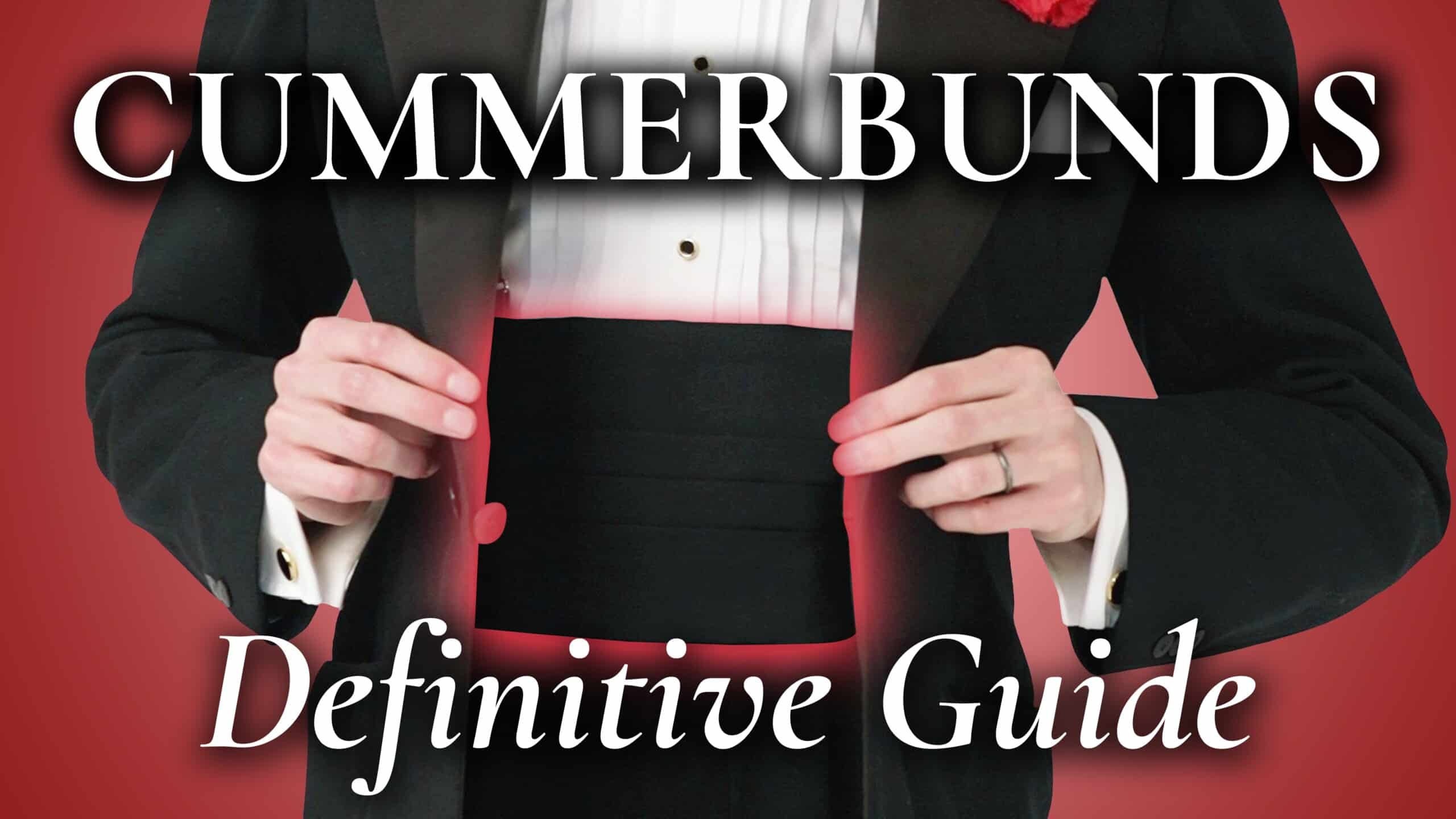

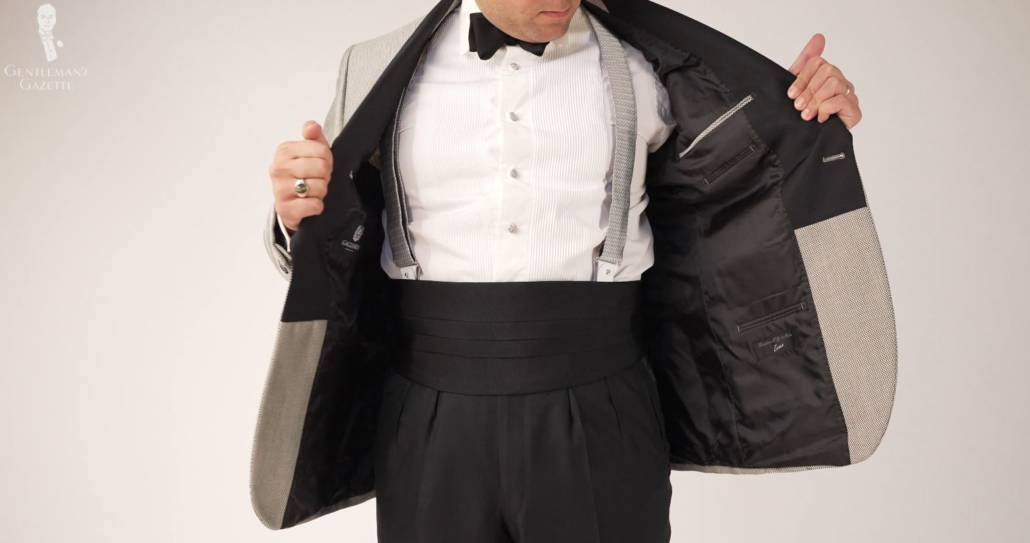
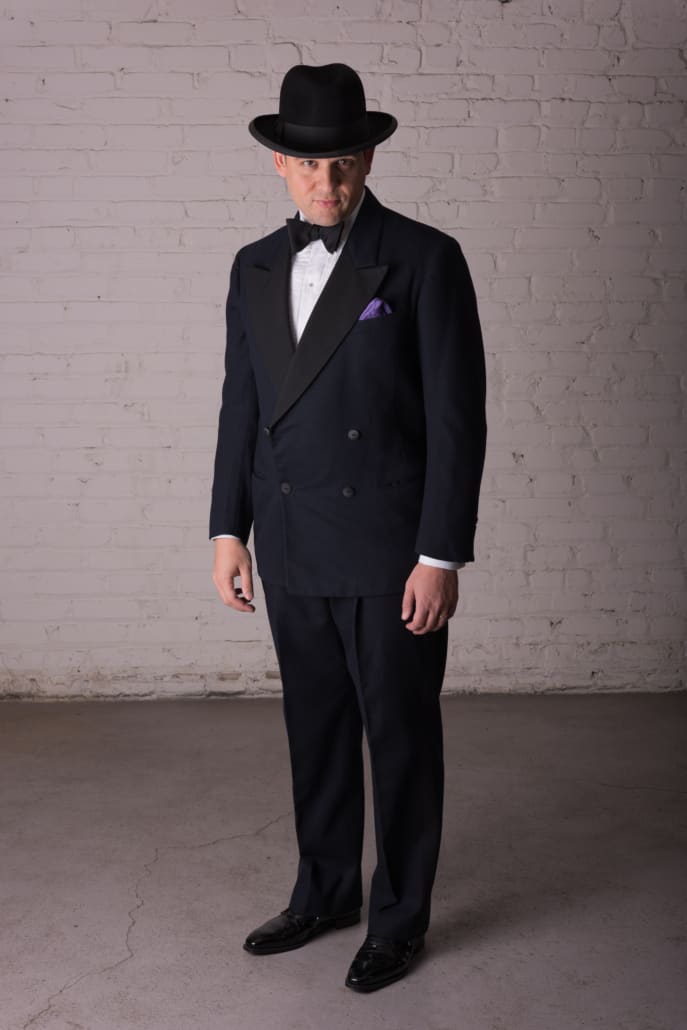
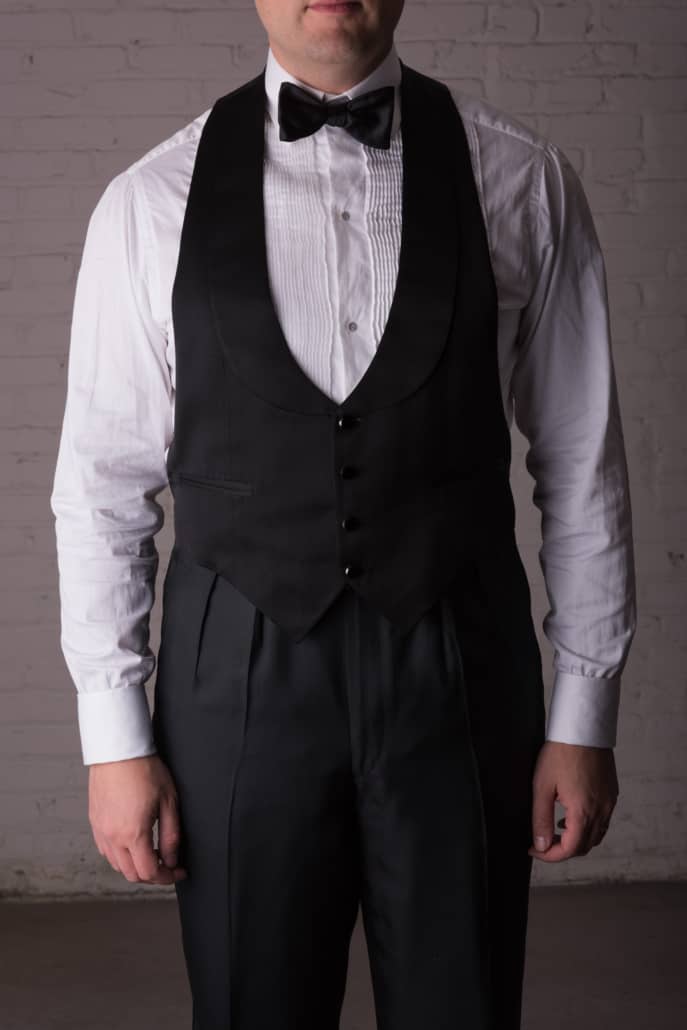
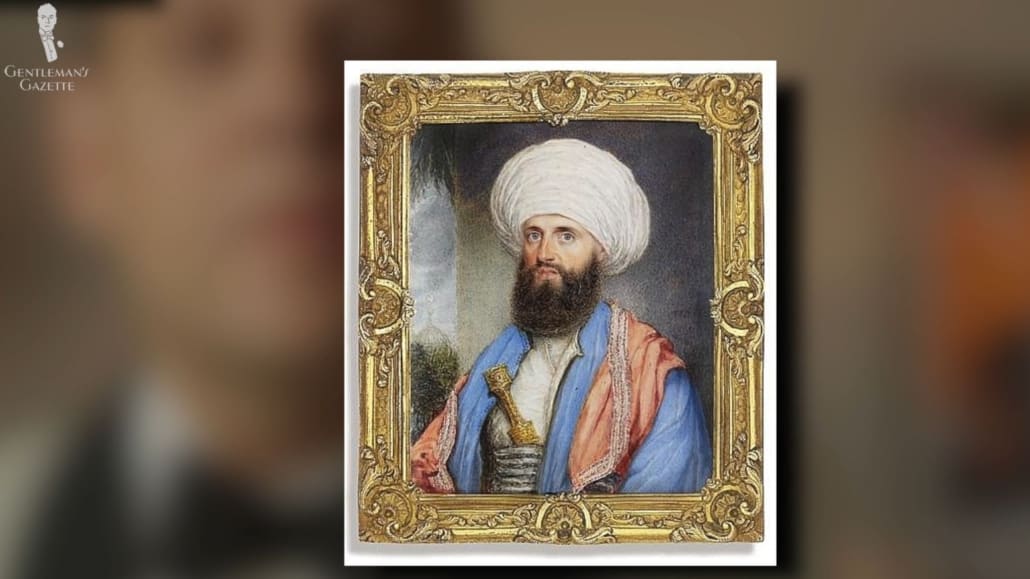
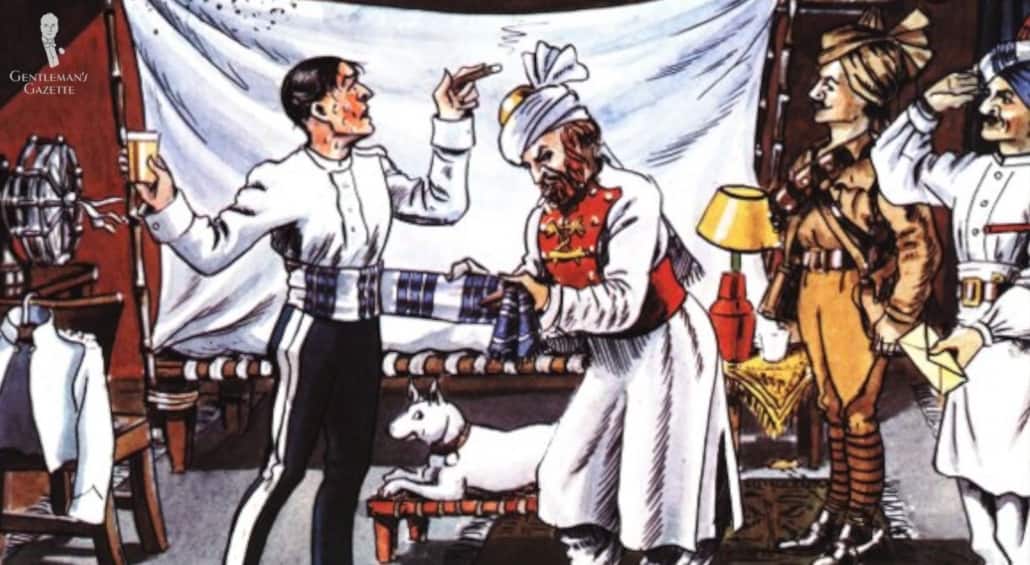

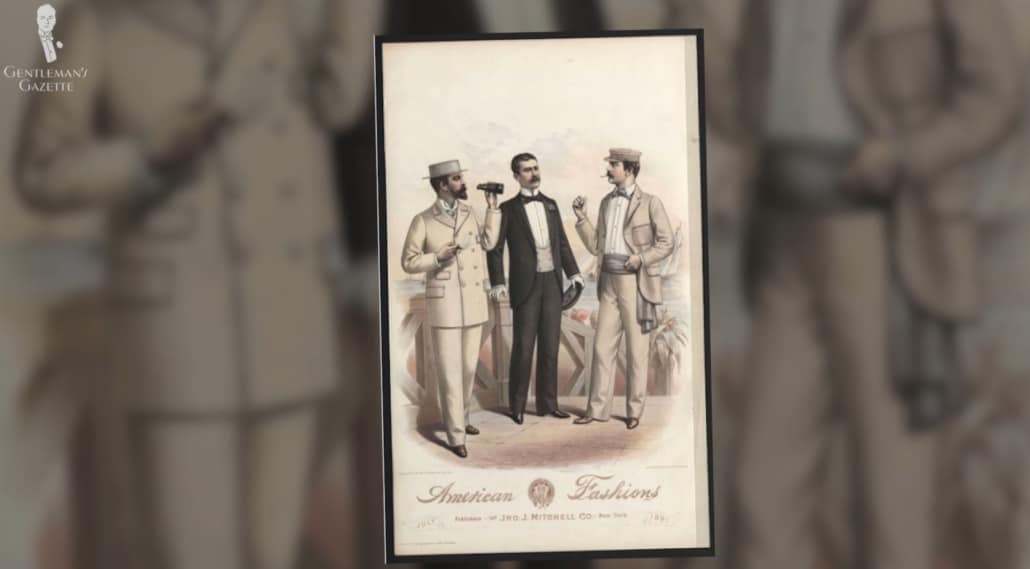
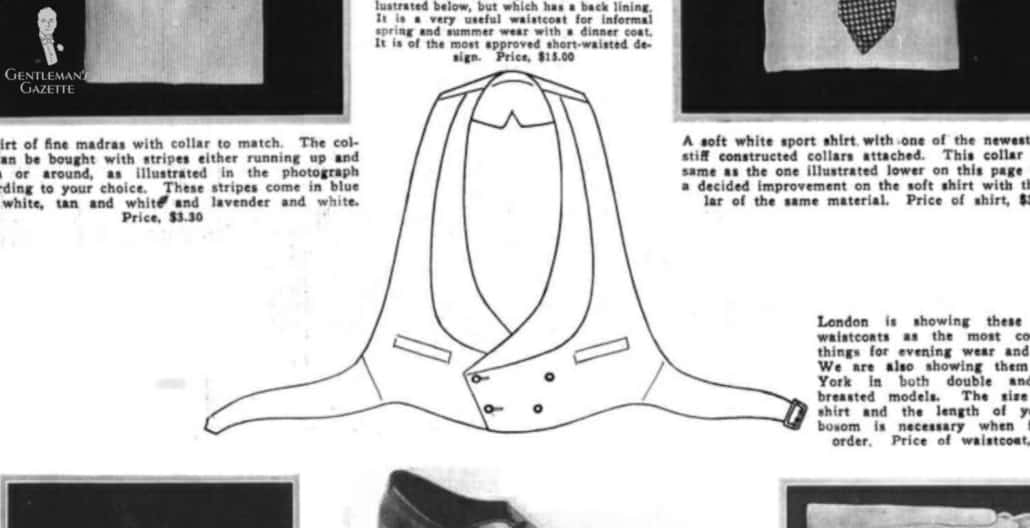
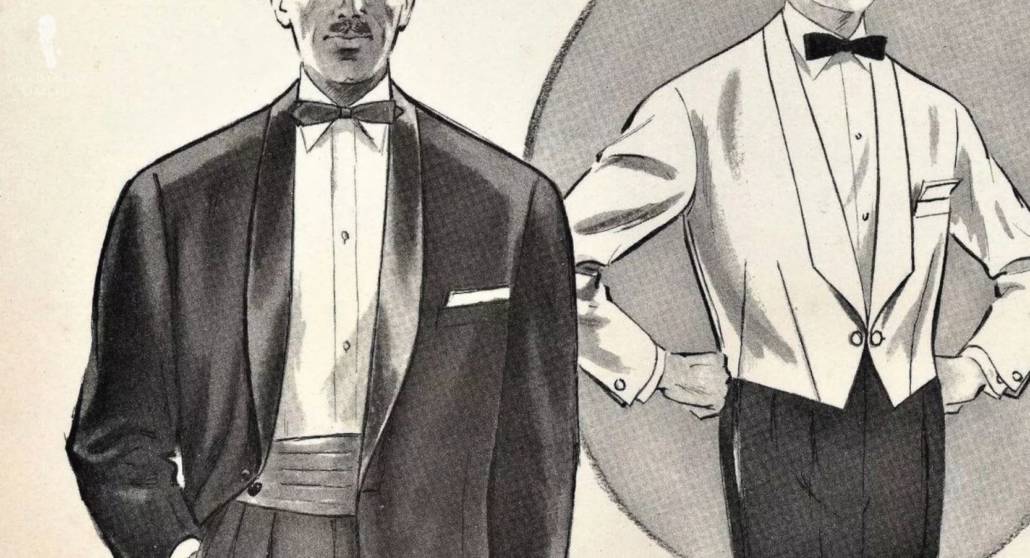
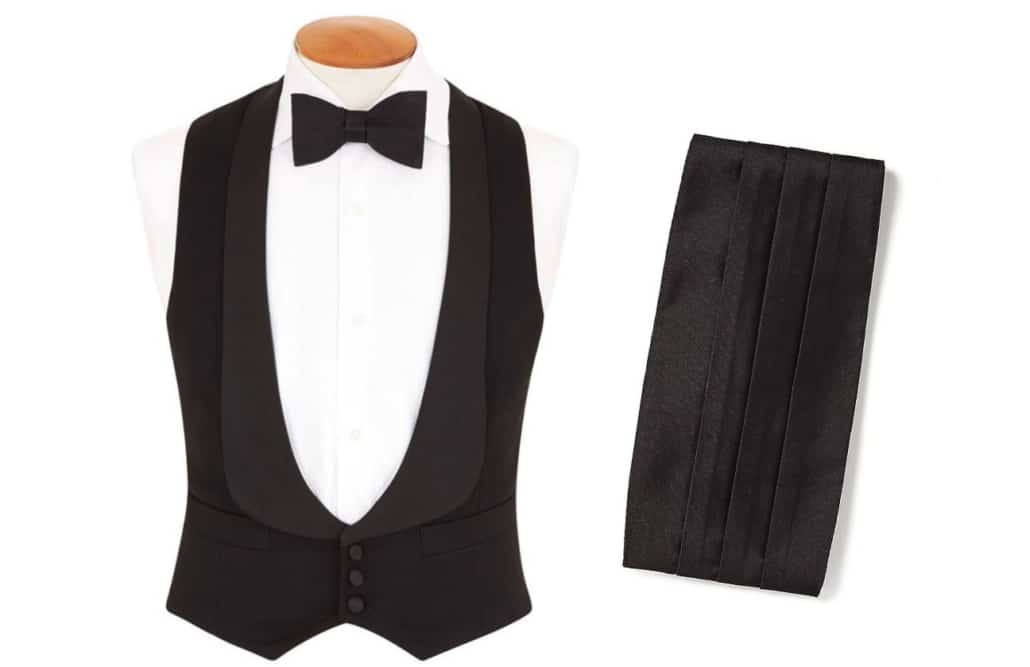
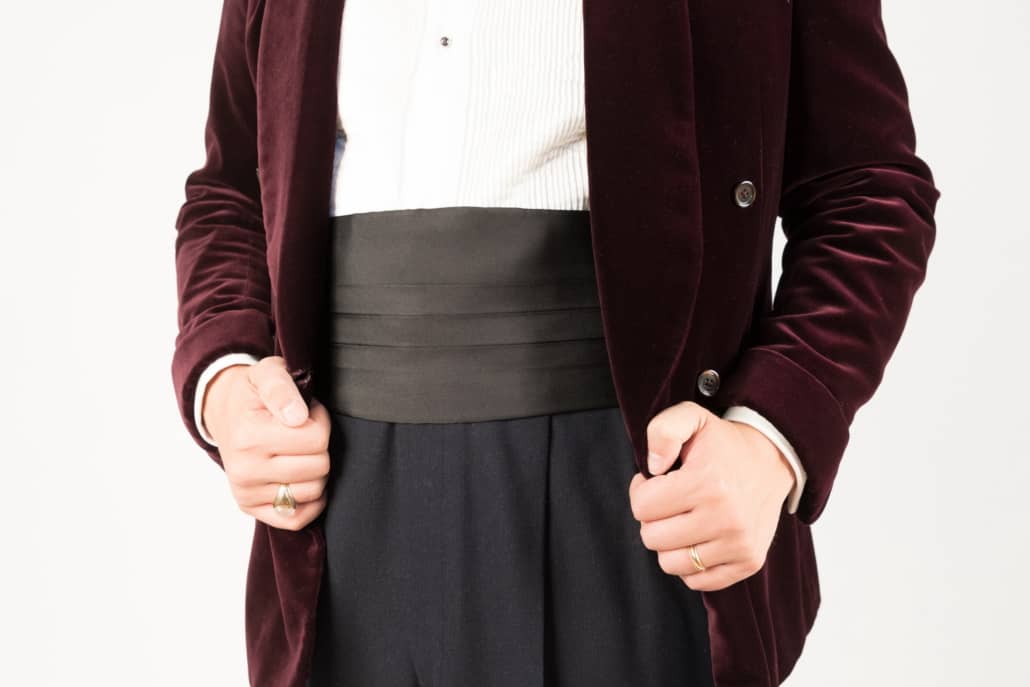
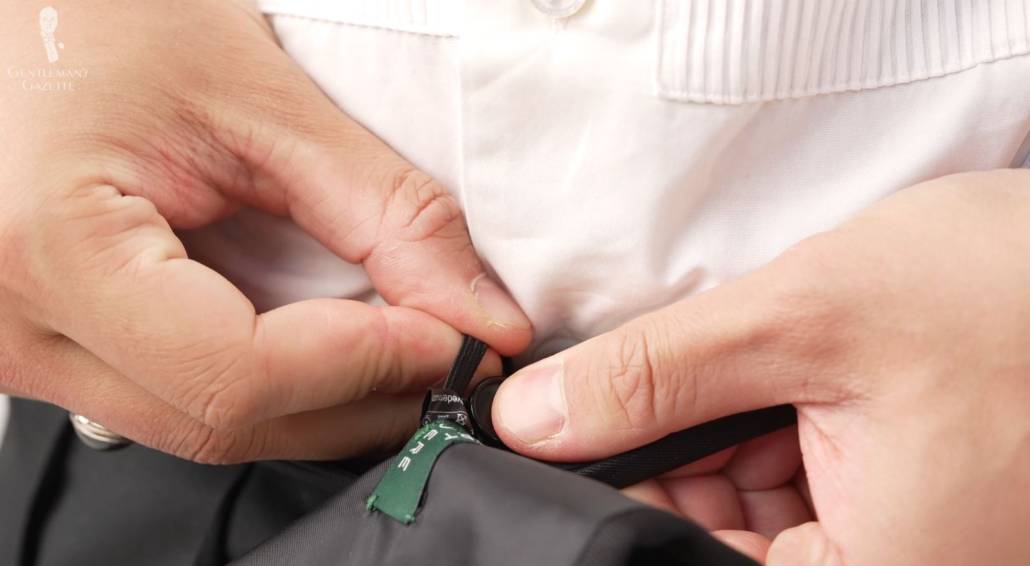
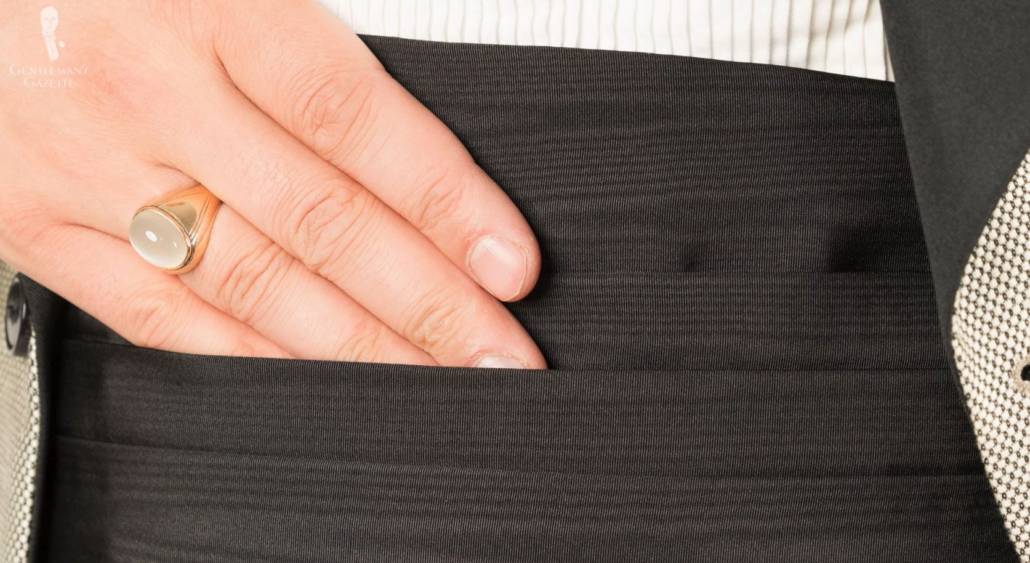
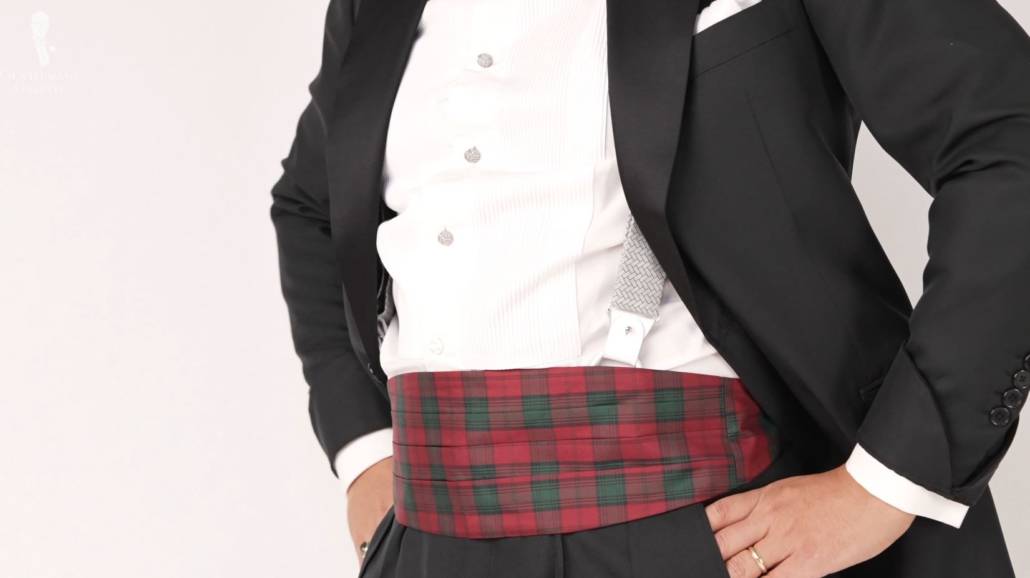
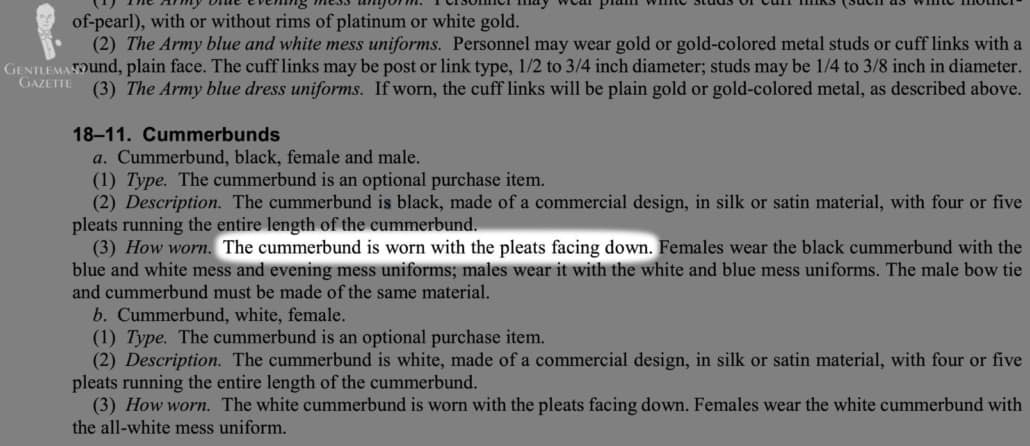
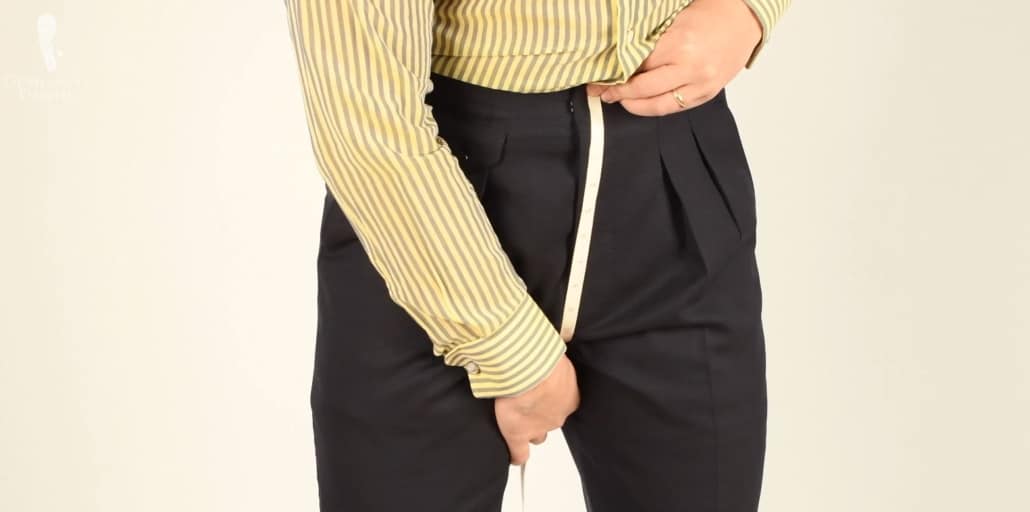
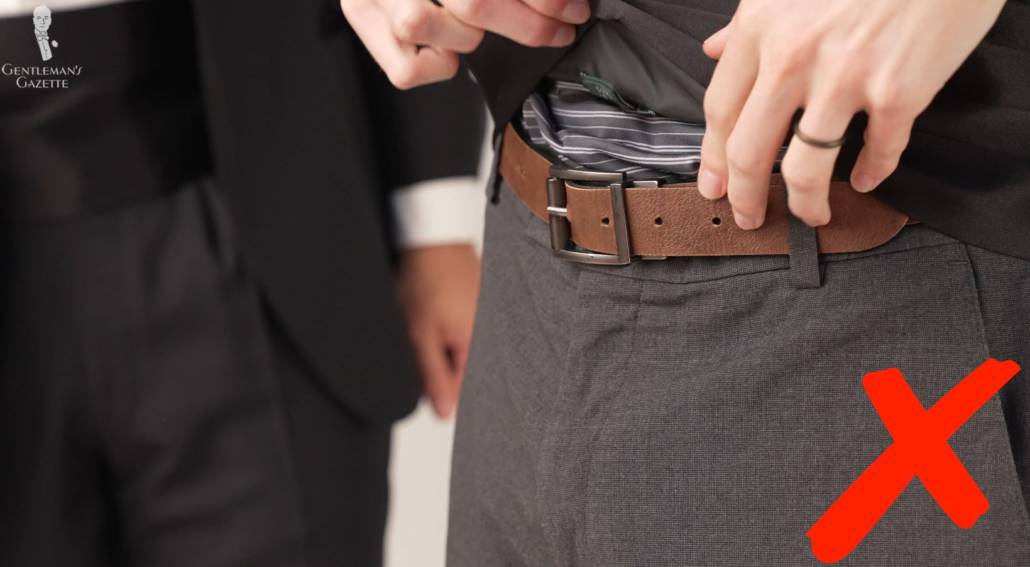
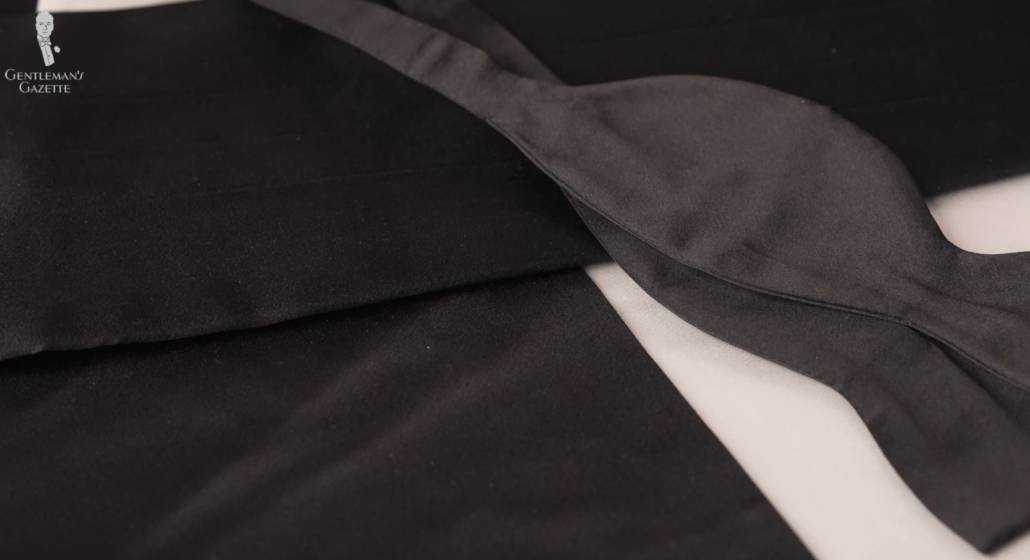
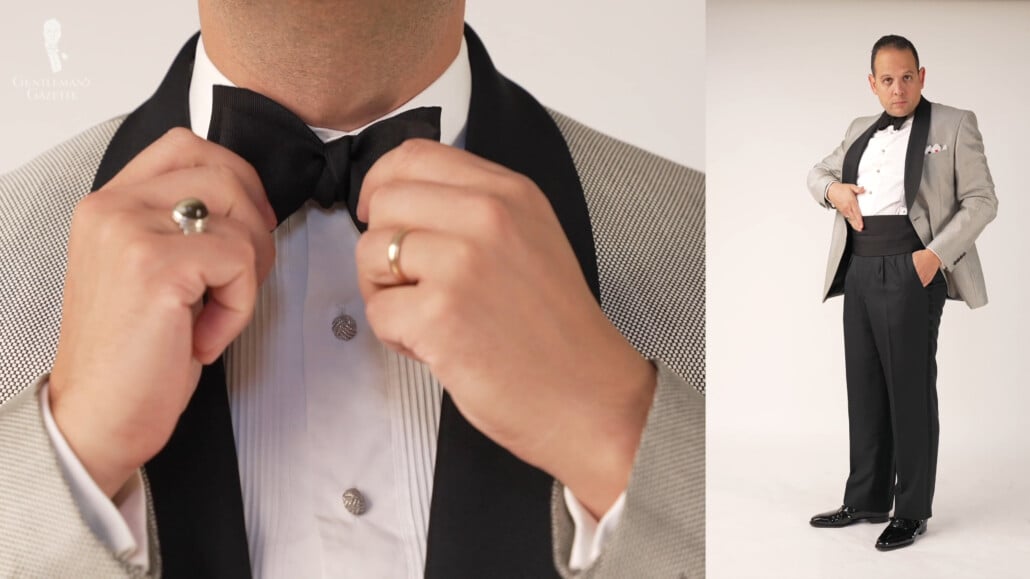
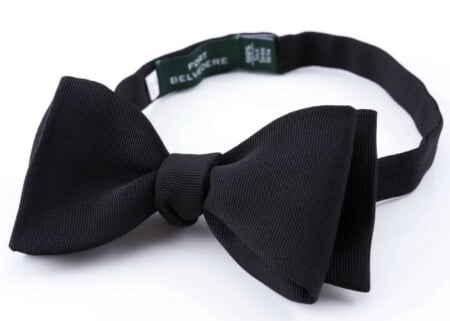
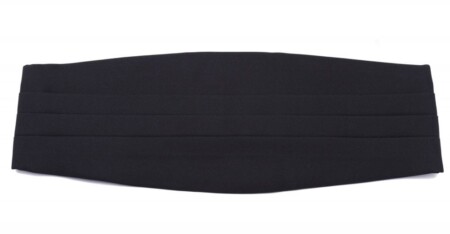
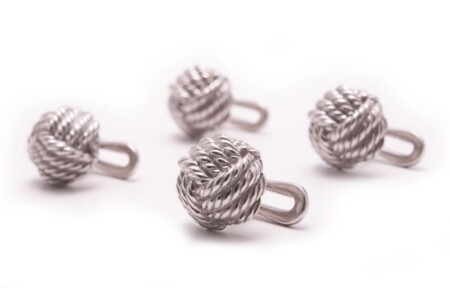
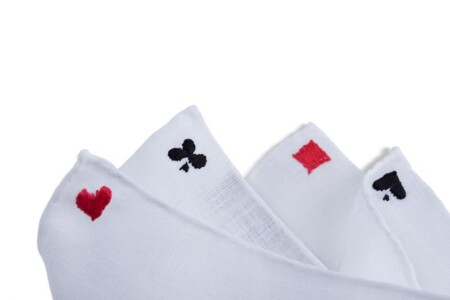
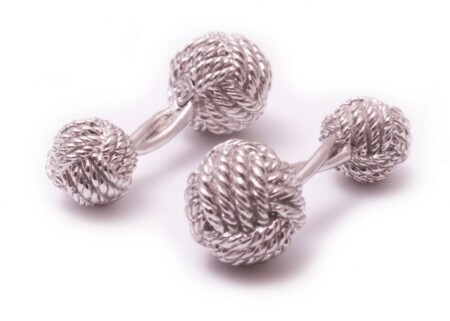
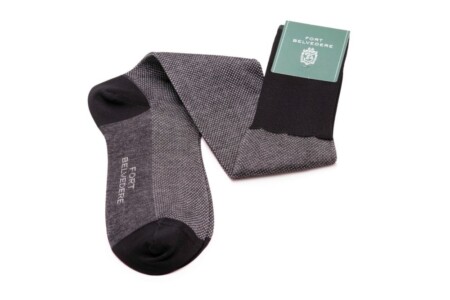
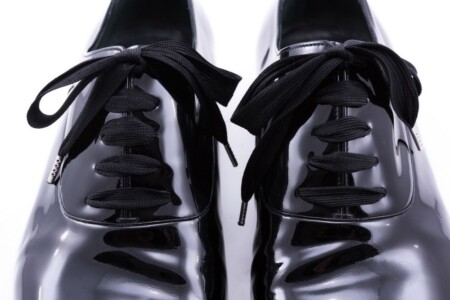
The US Army for its own reasons adopted the “pleats down” manner of wearing the cummerbund. The traditional original manner is with pleats facing up. Your article refers to the pleats facing up as a way for carry opera and theater tickets, and that would require the pleats to face up. Further, If one examines some of the better quality cummerbunds out there, it is easy to notice that with the curved edge worn properly facing down, one ends up automatically with the pleats facing up.
Nice review!
Furthermore, the US Navy Dress Uniform Regulation specifies that cummerbunds are worn pleats up!
https://www.mynavyhr.navy.mil/References/US-Navy-Uniforms/Uniform-Regulations/Uniform-Components/3501_20/
And the US Marine Corps Uniform Regulations specify that ….. ” 2. Cummerbunds will be worn with the pleats opening towards the top.”
https://www.marines.mil/portals/1/Publications/MCO%201020.34H%20v2.pdf?ver=2018-06-26-094038-137
Also, the US Air Force Mess and Dress uniform instruction:
“…. The cummerbund is worn with the Mess Dress Uniform and will be plain blue-satin, worn half way between the shirt and trouser’s, with the open edge of the pleats facing upward.
https://www.afpc.af.mil/Portals/70/documents/DRESS%20AND%20APPEARANCE/dafi36-2903.pdf?ver=1wambVteT78nTFgOwxZ32g%3d%3d
In conclusion, the *correct and traditional” method of wearing the cummerbund is with pleats facing up.